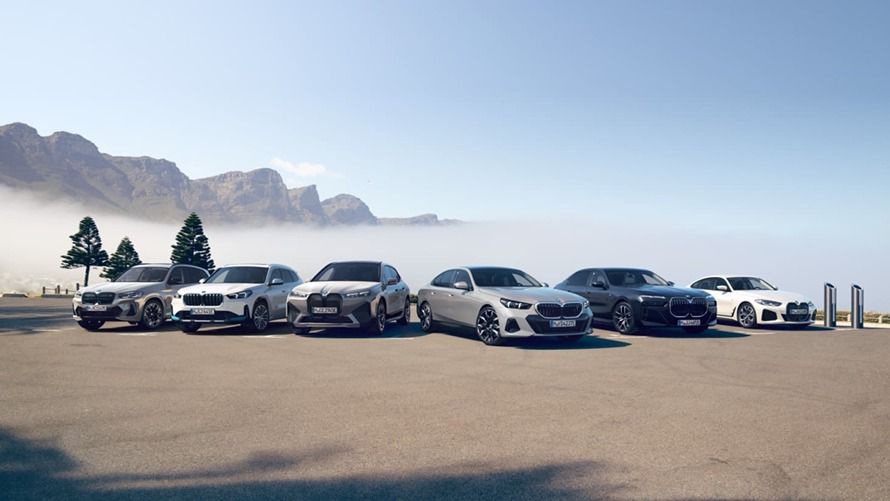BMW iX2 xDrive30[1]: Energy consumption, combined WLTP in kWh/100 km: 17.7-16.3; Electric range, WLTP in km: 417-449
THE CURRENT BMW X SERIES.
The hallmark of the BMW X Series is individual vehicles that carry the typical X genes. A sporty, robust design meets uncompromising performance. With this SUV, the clear view from the seat position, the intelligent BMW xDrive all-wheel drive and the excellent fuel efficiency allow you to explore the world in a new and exciting way.
- 455 (619) kw (HP)
- 0–100 in 3.8 Sec
BMW iX M60.
BMW iX M60[1]: Energy consumption, combined WLTP in kWh/100 km: 24.7–21.9; Electric range, WLTP in km: 501–564
- up to 385 (523) kw (HP)
- 0–100 in 4.6 Sec
BMW iX.
- up to 210 (286) kw (HP)
- 0–100 in 6.8 Sec
BMW iX3.
- up to 230 (313) kw (HP)
- 0–100 in 5.6 Sec
BMW iX2.
- up to 230 (313) kw (HP)
- 0–100 in 5.6 Sec
BMW iX1.
- up to 550 (748) kw (HP)
- 0–100 in 3.8 Sec
BMW XM Models.
- up to 221 (300) kw (HP)
- 0–100 in 5.4 Sec
BMW X2 M35i xDrive.
BMW X2 M35i xDrive: Fuel consumption, combined WLTP in l/100 km: 8.0–7.7; CO2 emissions, combined WLTP in g/km: 181-174
- up to 280 (381) kw (HP)
- 0–100 in 5.4 Sec
BMW X6.
- up to 280 (381) kw (HP)
- 0–100 in 5.4 Sec
BMW X5.
- up to 100 (136) kw (HP)
- 0–100 in 9.2 Sec
BMW X1.
FURTHER TOPICS.

BMW ELECTROMOBILITY.
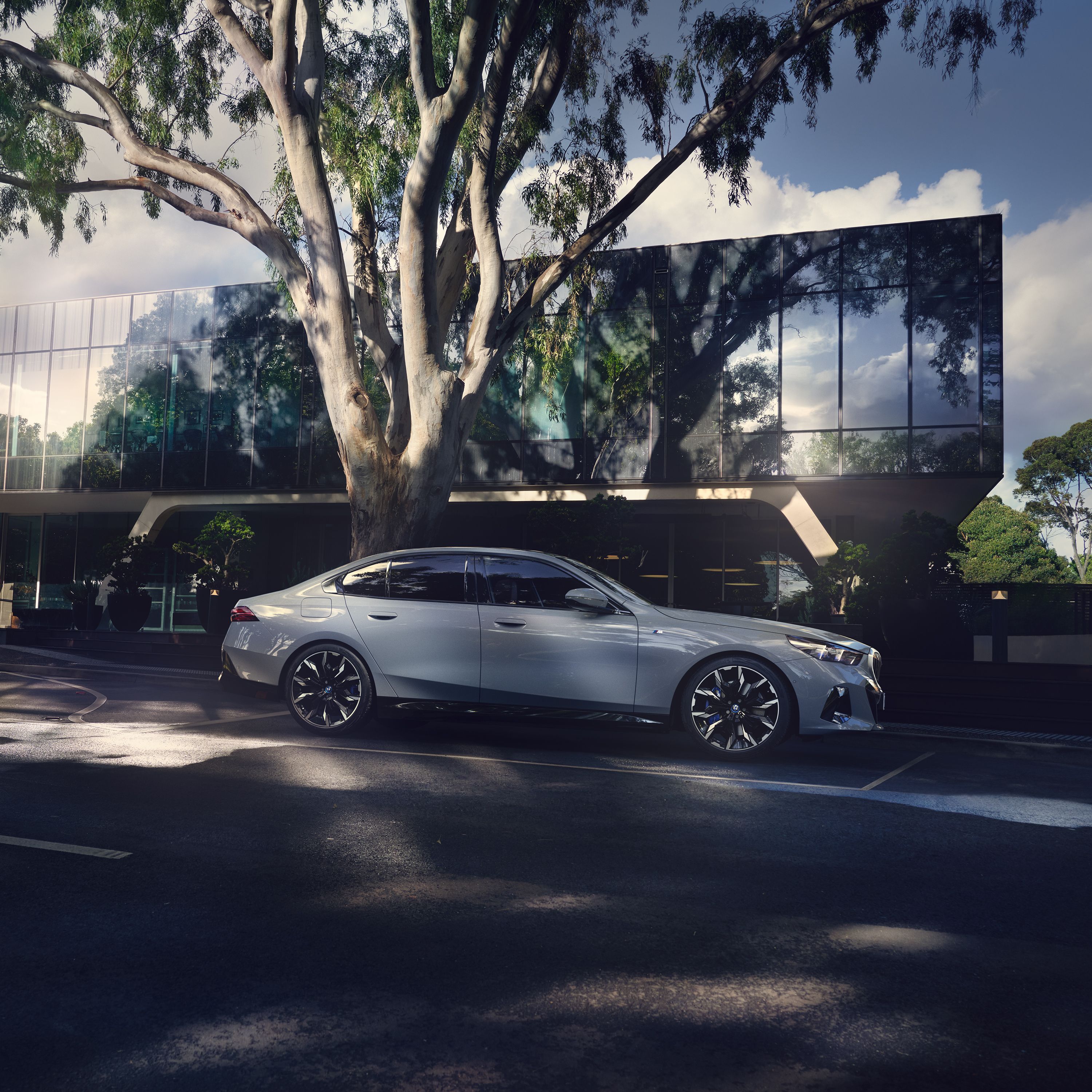
BMW FINANCIAL SERVICES.
AN OVERVIEW OF THE BMW X SERIES.
Step into the world of the BMW X series. And all the advantages offered by the wide range of BMW SUV models. Whether you’re going for an efficient electric SUV, a flexible plug-in hybrid model or a combustion engine. From small, compact cars to large 7-seater models and luxurious comfort off-road vehicles. Used or new. Find the SUV that ideally suits your life.
THE BMW X1.
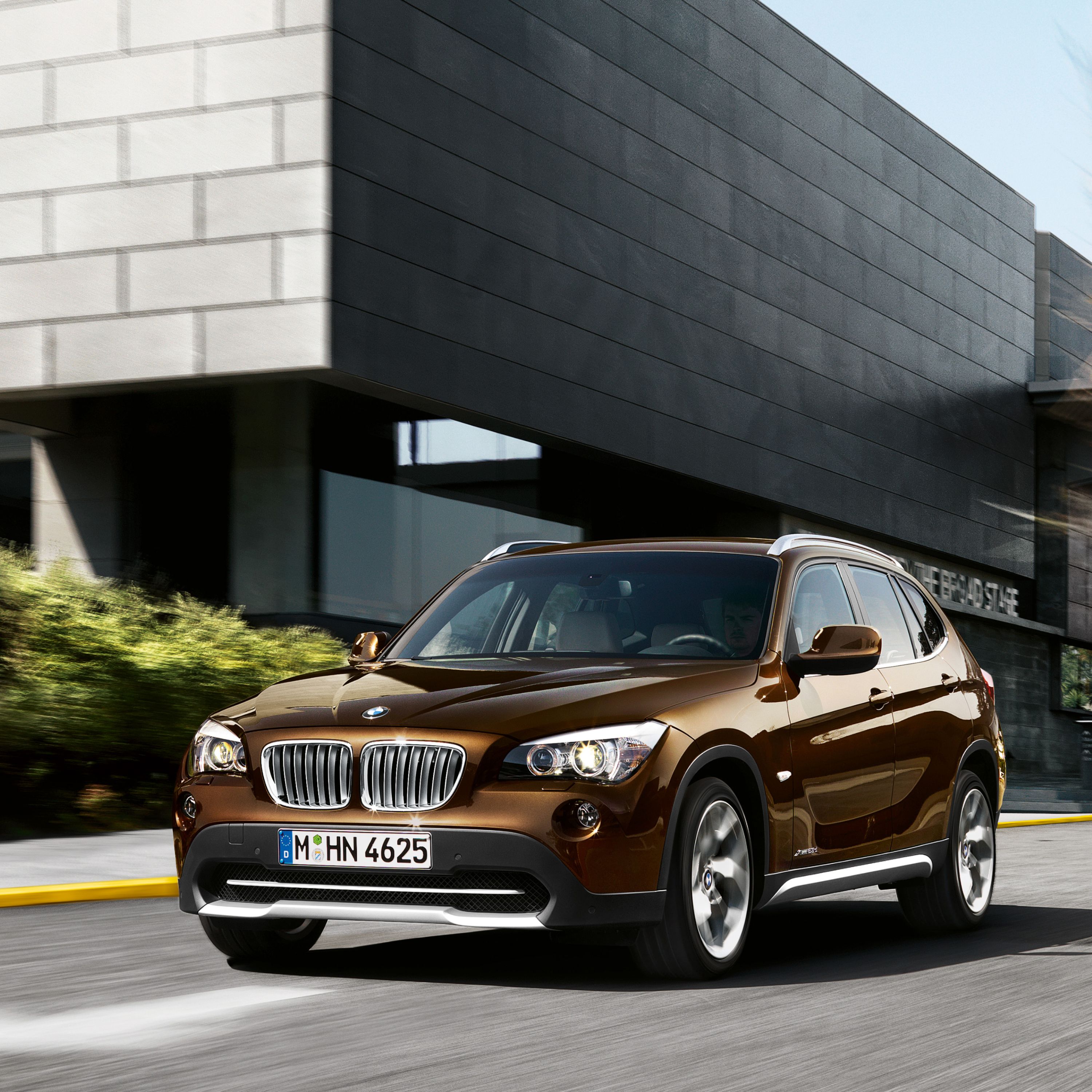
THE FIRST GENERATION (BMW E84).
With its market introduction in 2009, the BMW X1 goes straight to the forefront of the premium compact SUV segment. Robust and versatile on the one hand, sporty and agile on the other. The intelligent BMW xDrive all-wheel drive distributes the driving power steplessly to the front and rear wheels. The resulting traction and driving dynamics reach an excitingly high level.
Visually, its exterior leaves a sporty and powerful impression. The interior equipment impresses with colour-coordinated trim strips and high-quality stainless steel inserts.
Production period: 2009 – 2015
Engines: 2.0 – 3.0 liters (85 – 225 kW, 116 – 306 hp), 4- & 6-cylinder
Length/width/height: 4,454 mm / 1,798 mm / 1,545 mm
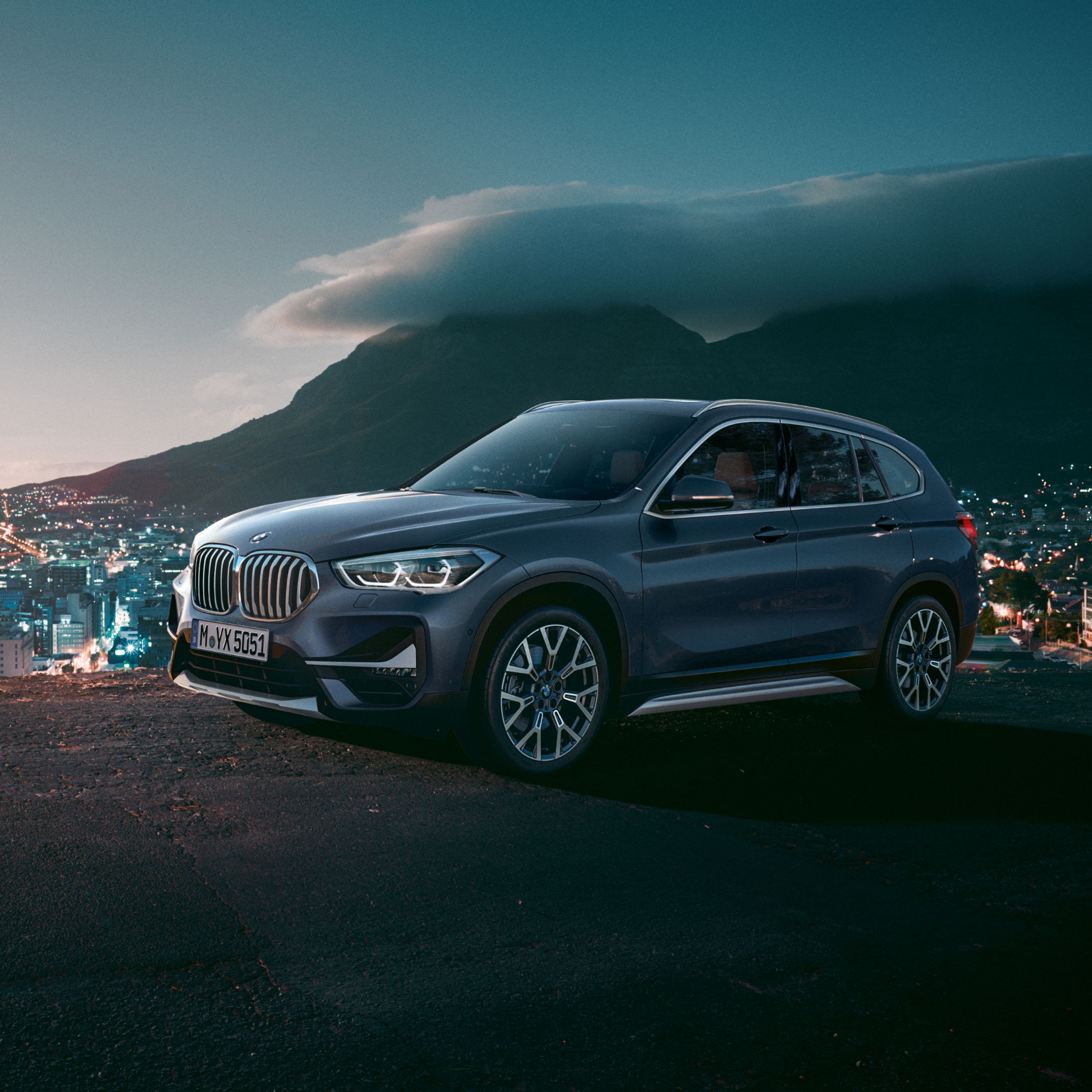
THE SECOND GENERATION (BMW F48).
Whether it's the strident lines rising towards the rear, or the sloping roof: the sporty design of the second-generation BMW X1 makes it even more dynamic. Thanks to innovative equipment such as a BMW head-up display or optionally available LED headlights with adaptive lighting function, the off-roader impresses with modern technologies. A new generation of turbocharged diesel and petrol engines ensures an extraordinary interplay of efficiency and sportiness. What's more, the SUV has also been available as a plug-in hybrid model since March 2020. In addition to the agile all-wheel drive BMW xDrive, it is now also available with front-wheel drive.
Thanks to the significantly more prominent double kidney and wider air inlets on the sides of the front apron, the vehicle looks even more elegant since receiving its 2019 facelift.
Production period: 2015 – 2022
Engines: 1.5 – 2.0 litres (85 – 170 kW, 116 – 231 hp), 3 & 4 cylinders
Length/breadth/height: 4,439 – 4,447 mm/1,821 mm/1,582 – 1,612 mm
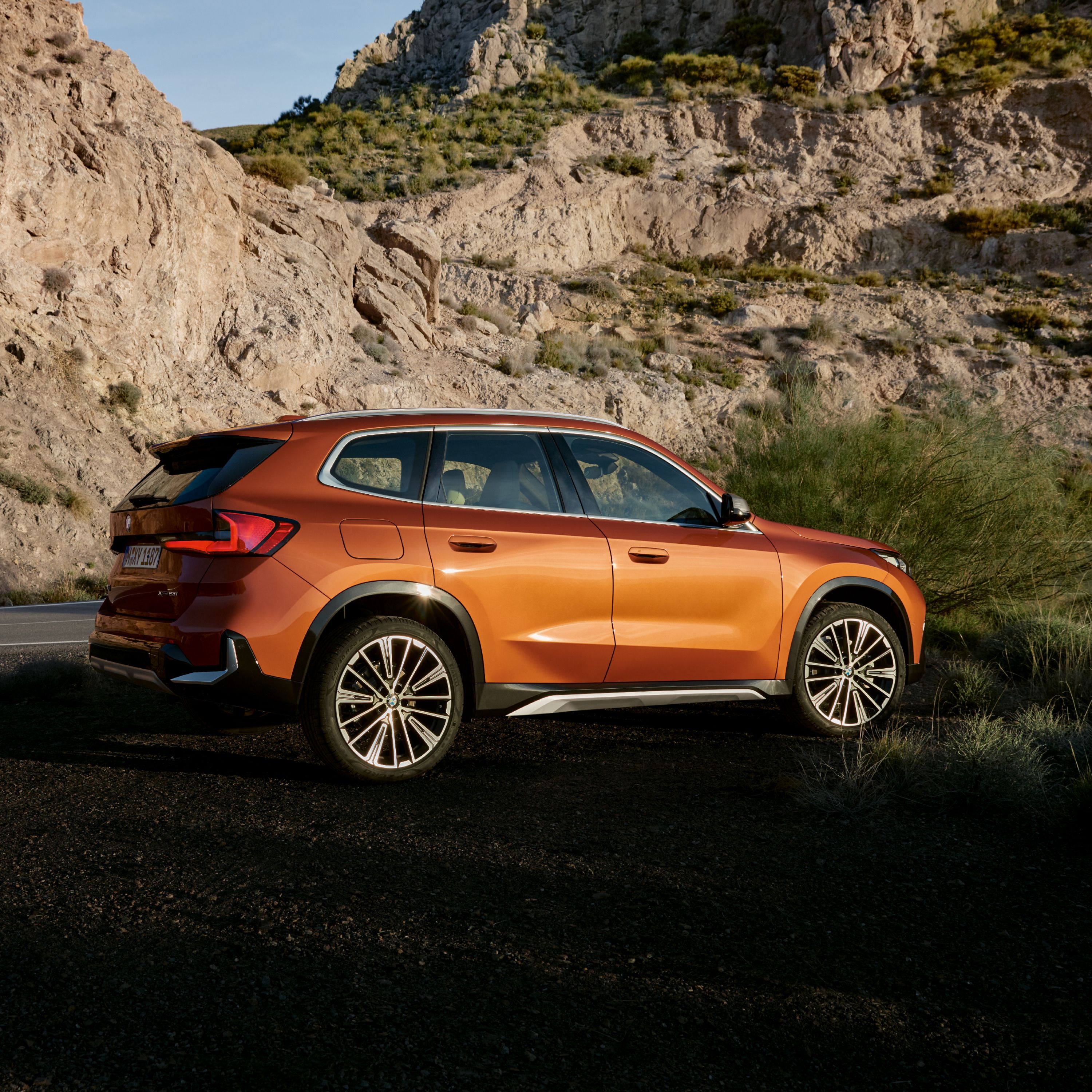
THE THIRD GENERATION (BMW U11).
Since 2022, the BMW X1 has been as confident as it is versatile and functional. It is available as a combustion engine, plug-in hybrid or fully electric model. Its clear design language gives it a commanding presence: whether through the prominent front end with the striking, almost quadratic double kidney grille, the monolithic design elements, or the almost angular wheel arches typical of the X series.
The slim, Adaptive LED Headlights, which extend far into the flanks, set dynamic accents. The same goes for the upright proportions.
The mixture of power and dynamics is also reflected in the technical equipment. The BMW X1 is available either with front-wheel drive or with the agile BMW xDrive system. In addition to enhanced driving dynamics, this also offers a high degree of traction and driving safety. The automatic 7-speed Steptronic transmission with double clutch stands for high shifting and driving comfort with low fuel consumption. The plug-in hybrids enable a purely electrical range (WLTP) of up to 86 km[1].
Production period: 2022 – present
Engines: 1.5 – 2.0 litres (100 – 240 kW, 136 – 326 hp)[2], 3 & 4 cylinders
Length/breadth/height: 4,500 mm/1,845 mm/1,630 – 1,642 mm
THE BMW X2.
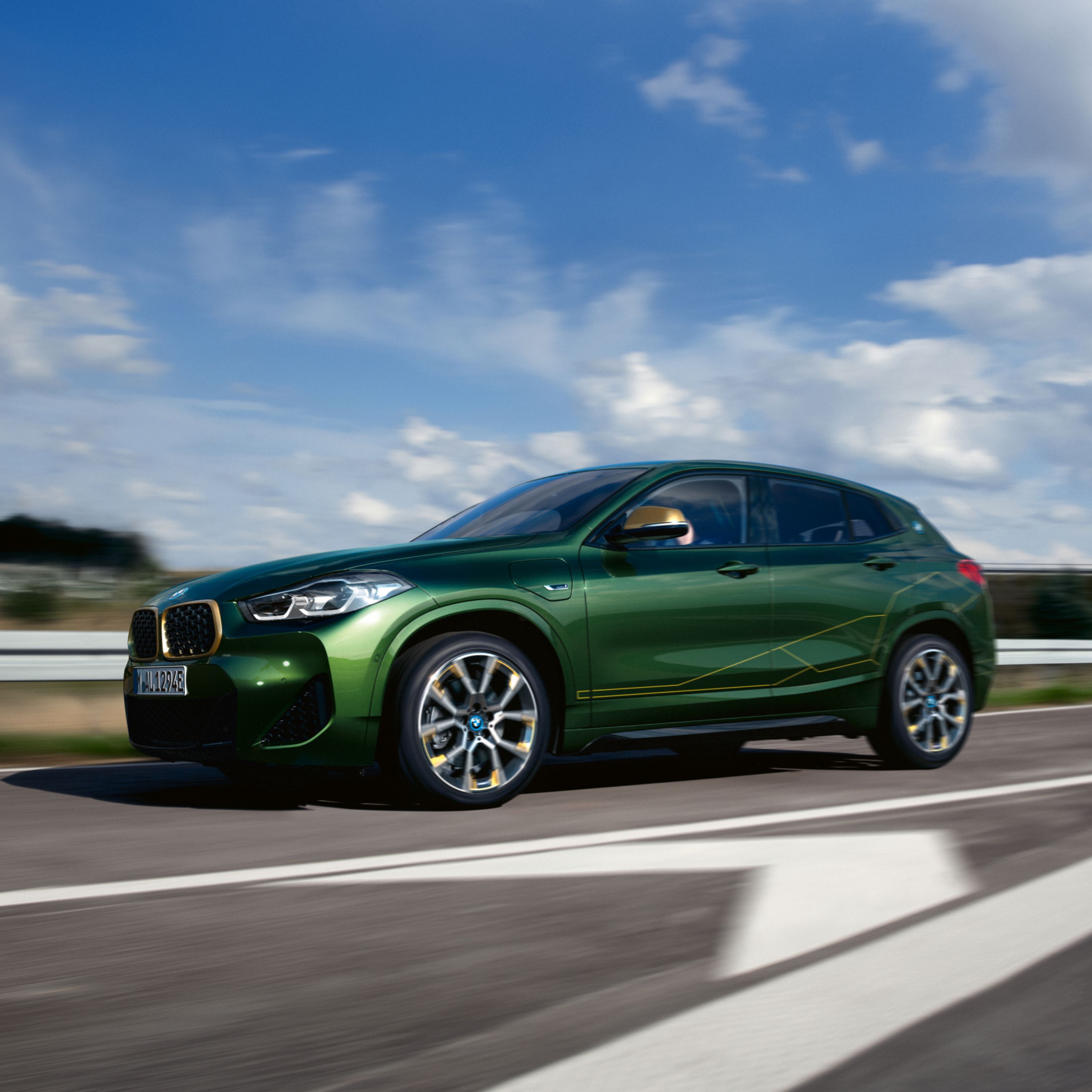
THE FIRST GENERATION (BMW F39).
As a concept vehicle based on the BMW X1, the BMW X2 came into the world in 2016. . Since then, the SUV model has inspired us with its expressive design and technological brilliance. Almost square-cut wheel arches boast an exclusively extroverted character together with the flat roof line. In the front, the double kidney grille that widens towards the bottom and the air inlets signal self-confidence.
In terms of driving dynamics, the BMW X2 is also ahead of the pack of the smaller SUV models. Modern turbo engines in combination with the Steptronic transmissions have power at the ready. With the optional BMW xDrive all-wheel drive, the Coupé SUV also feels comfortable beyond the urban environment. On any surface, in fact. Reminiscent of legendary BMW models like the 2000 CS and the 3.0 CSL are the BMW logos on the C-pillar.
Production period: 2018 – present
Engines: 1.5 – 2.0 litres (100 – 225 kW, 136 – 306 hp), 3 & 4 cylinders
Length/breadth/height: 4,360 mm/1,824 mm/1,512 – 1,526 mm
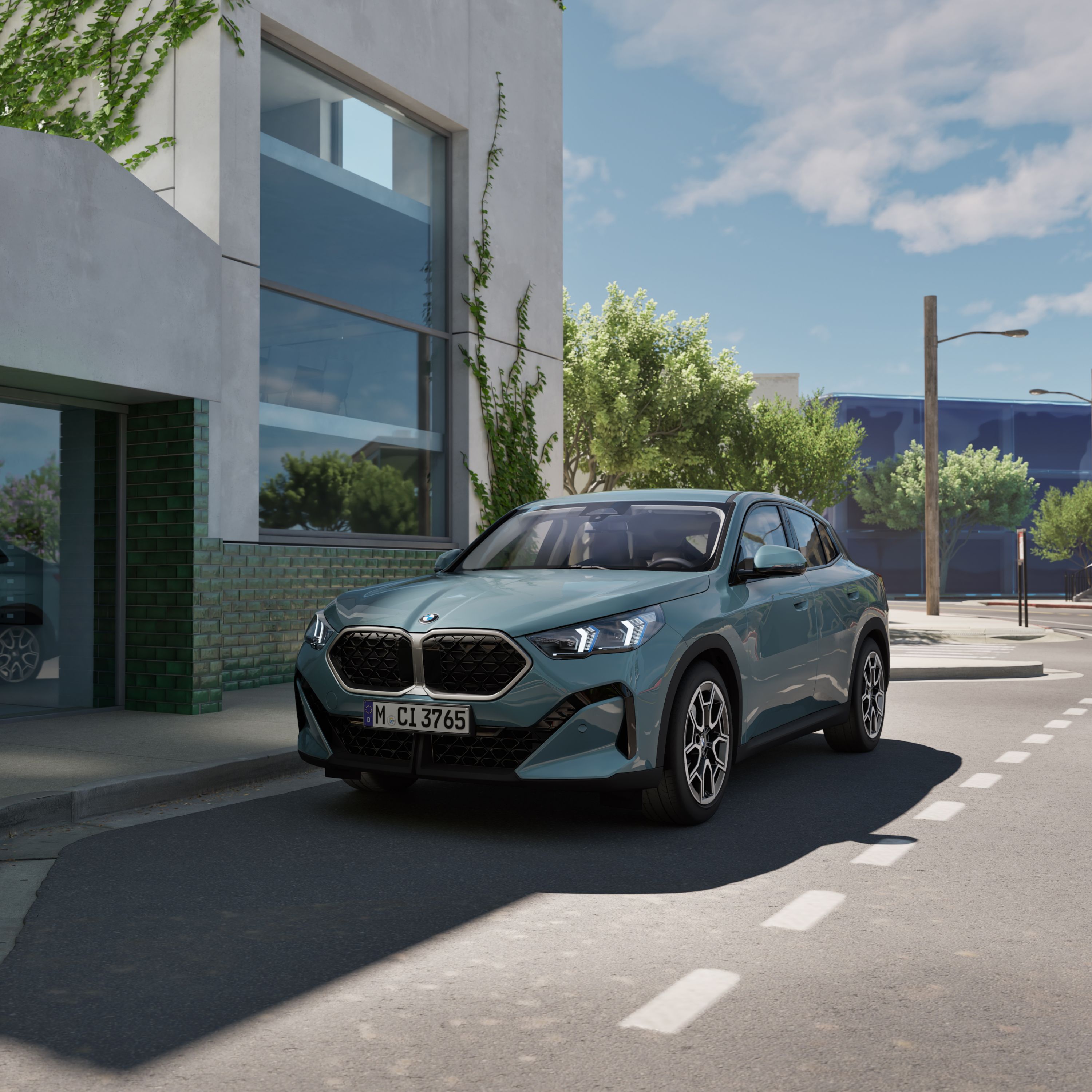
THE SECOND GENERATION (U10).
The second-generation BMW X2 arrived in 2024. The SUV’s design is characterised by powerful lines and a coupé silhouette. At the front, the sporty kidney grilles in mesh design accentuate its striking appearance. At the front and rear, lights with state-of-the-art LED technology ensure an athletic design and optimum visibility.
In the interior you are welcomed by high-quality materials, innovative technology and ergonomic comfort. The upholstery of perforated synthetic leather is a real eye-catcher and offers incredibly comfortable seating. Innovative entertainment programmes with gaming and video streaming are there to be enjoyed in comfort. Use the navigation and vehicle settings on the large BMW Curved Display and the BMW Live Cockpit Professional. And the premium panoramic glass sunroof opens up the space above, making the interior appear even larger from every seat.
With 125 kW (170 hp)[3] of power, the BMW X2 accelerates to a maximum speed of 213 km/h. Experience thrilling driving dynamics and benefit from the help of intelligent driver assistance systems, like the Parking Assistant Plus, for example, which also provides a 3D view of your surroundings. Or the Driving Assistant Professional, which safely maintains your lane and distance up to 210 km/h.
Production period: from 2024
Engines: 1.5 – 2.0 litres (110 – 221 kW, 150 – 300 hp), 3 & 4-cylinder
Length/breadth/height: 4,554 – 4,567 mm/1,845 mm/1,575 – 1,590 mm
THE BMW X3.
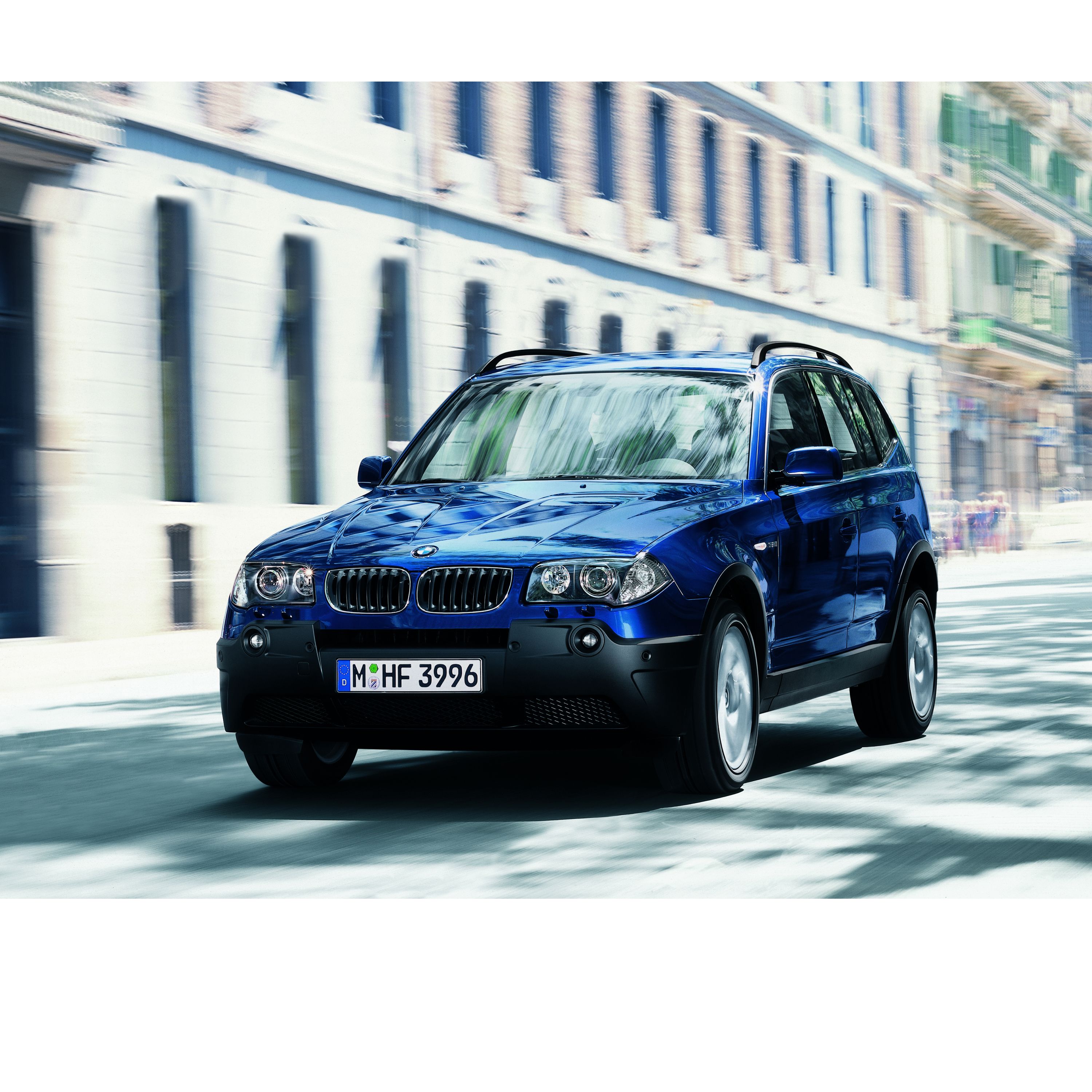
THE FIRST GENERATION (BMW E83).
In 2003, the BMW X3 is introduced at the 60th IAA. There, the off-roader is presented almost without competition. The intelligent BMW xDrive all-wheel drive system is new and makes its debut here. It steplessly distributes the force between the front and rear axles. The striking and athletic design also celebrates its première. For example, in the striking front, in which bi-xenon headlights line the double kidney grille. They show the characteristic side light rings that make BMW vehicles from this time clearly recognisable from a distance even in the dark.
A facelift is given in 2006. It refines the radiator grille, rear lights and front apron. The engines are now more efficient and significantly more powerful.
Production period: 2003 – 2010
Engines: 2.0 – 3.0 litres (105 – 210 kW, 143 – 286 hp), 4 & 6 cylinders
Length/breadth/height: 4,565 mm/1,853 mm/1,674 mm
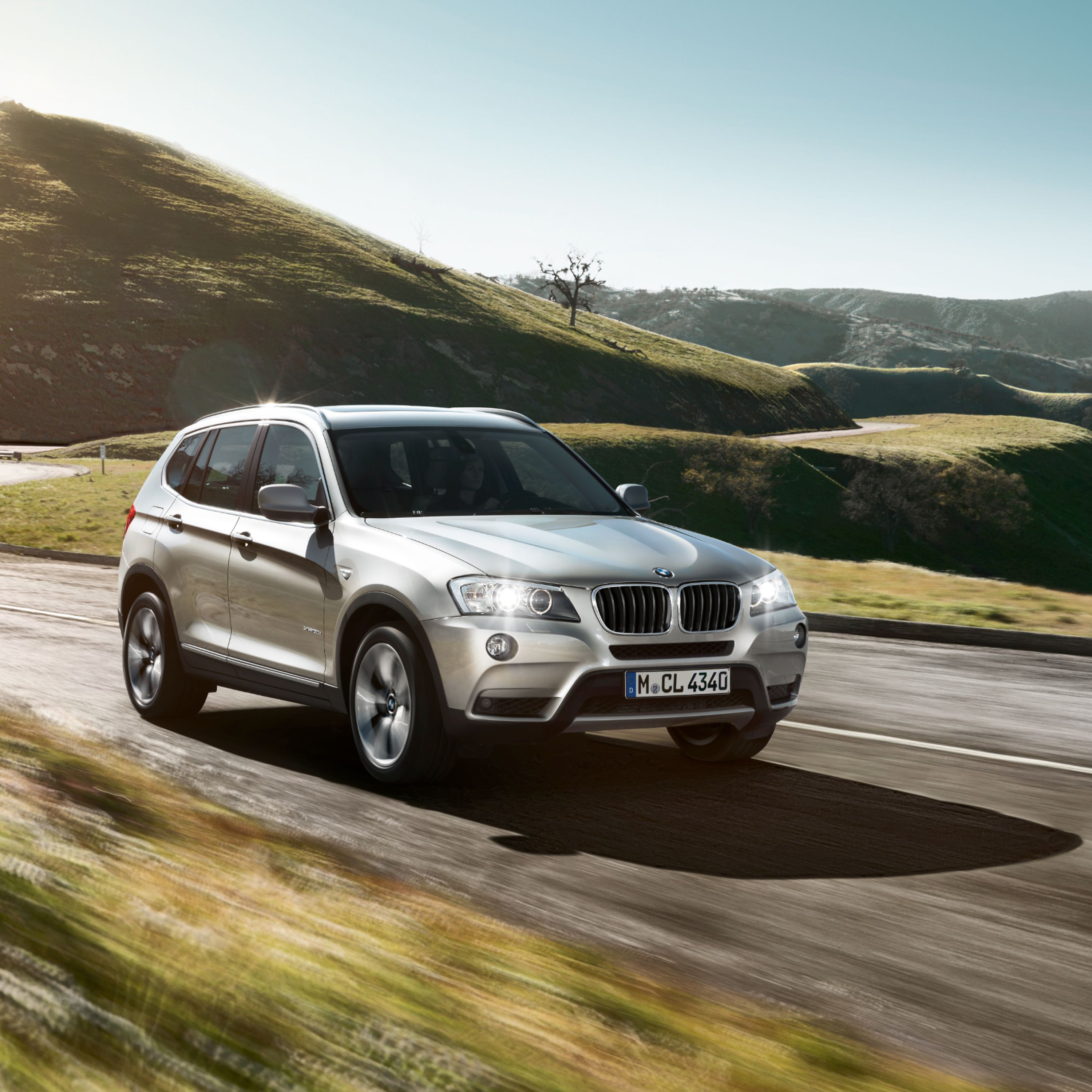
THE SECOND GENERATION (BMW F25).
Six years later, the successor appears with a completely new design. Confident and competent with a whole range of new features. For example, electronically controlled dampers that actively adapt to the road surface. And the driving dynamics control, which allows the engine to respond more spontaneously to accelerator pedal movements. This also applies to the dynamic gearshifts of the transmission as well as the sensitivity of the steering and the Dynamic Stability Control (DSC). A whole range of driver assistance systems, such as the Lane Keeping Assistant and the BMW head-up display, enable a wholly new driving experience. This without having to do away with the standard virtues of a BMW.
The SUV's 2014 model update introduces a new headlight design and side turn indicators in the exterior mirrors. The interior features more chrome, a standard leather steering wheel and significantly more options for customising the BMW X3.
Production period: 2010 – 2017
Engines: 2.0 – 3.0 litres (105 – 230 kW, 143 – 313 hp), 4 & 6 cylinders
Length/breadth/height: 4,648 mm/1,881 mm/1,661 mm
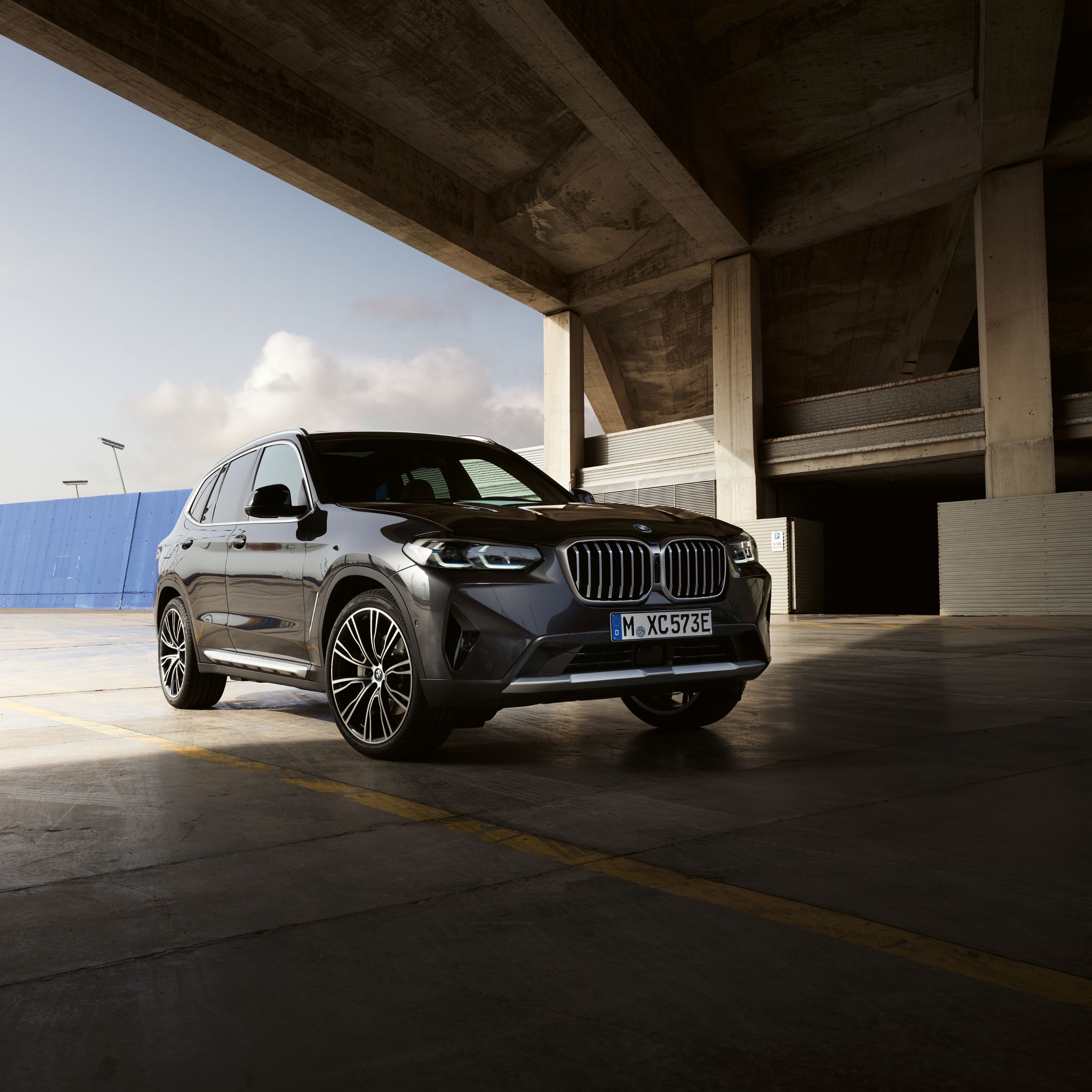
THE THIRD GENERATION (BMW G01 & F97).
The third generation of the SUV has been available since 2017. Although the model is larger than its predecessor, it still weighs less. This makes it particularly agile. The car’s headlights, radiator grille and rear lights emphasise its width. In conjunction with the wider double kidney grilles and air inlet openings, the BMW X3 is confident and athletic.
The cockpit is animated and modern and can be operated via BMW gesture control. The driver assistance systems are among the best of their kind. For example, the vehicle can overtake by itself. The chassis, transmission and engine have a sporty design. The intelligent all-wheel-drive BMW xDrive is also available. The car is suitable for any situation: whether in urban environments, the countryside or nature.
Production period: 2017 – present
Engines: 2.0 – 3.0 litres (135 – 375 kW, 184 – 510 hp)[2], 4 & 6 cylinders
Length/breadth/height: 4,708 – 4,734 mm/1,891 – 1,897 mm/1,667 – 1,676 mm
THE BMW X5.
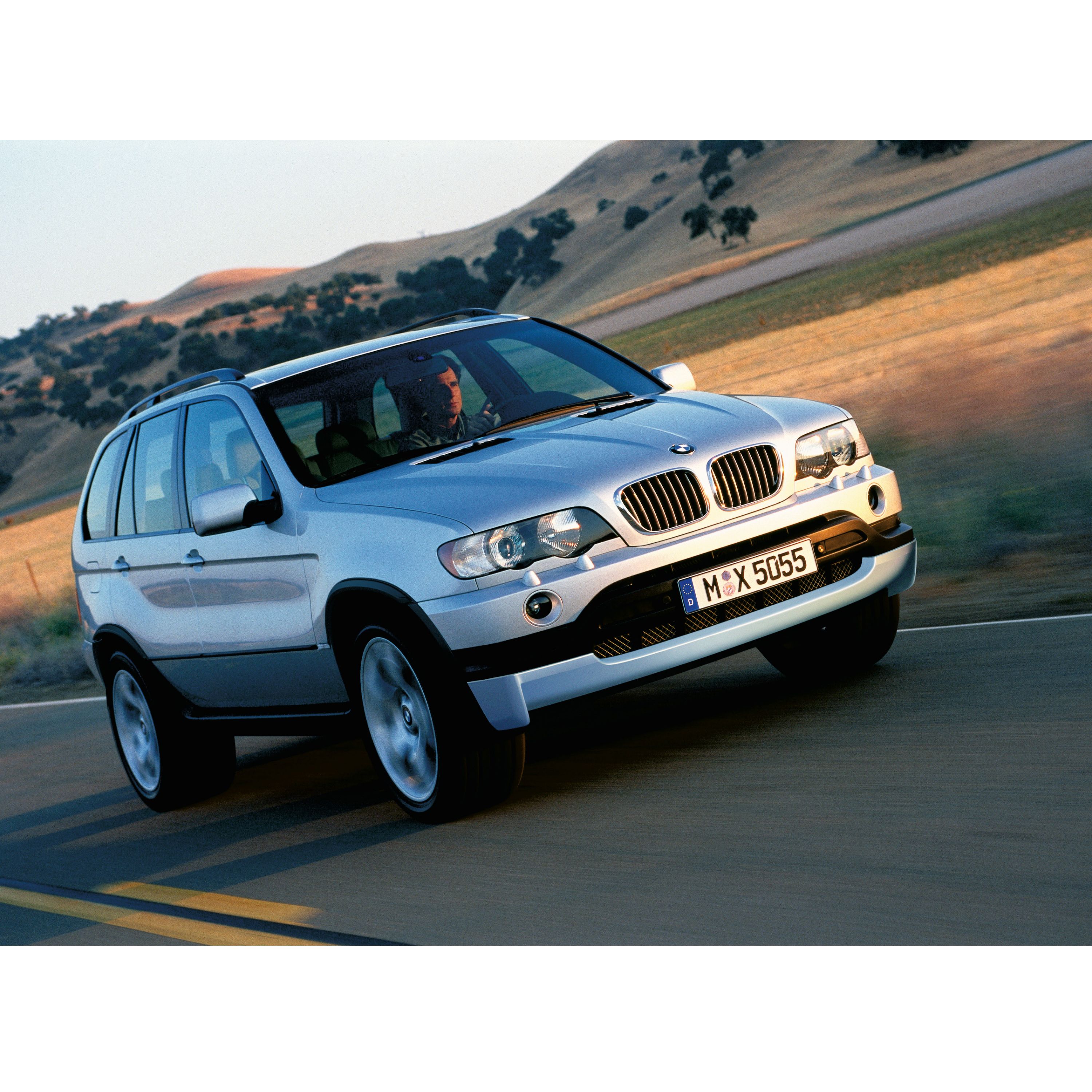
THE FIRST GENERATION (BMW E53).
Nothing less than a revolutionary innovation: in 1999, the first off-road vehicle from BMW was introduced to the world. The Sports Utility Vehicle (SUV) with all-wheel drive as standard combines exclusivity with sportiness and comfort. A premium-class vehicle with the agility you'd expect from a BMW. Not least thanks to the excellent chassis and suspension setup and powerful engines with six and eight cylinders.
In 2003, the facelift brings a more distinctive look through the revised double kidney grille. But also technical improvements in the form of the new BMW xDrive. Significantly improved traction and faster responsiveness deliver clear advantages in handling and dynamics. In 2004, the most powerful eight-cylinder engine becomes available – with the BMW X5 4.8is. Its displacement of 4.8 litres and output of 265 kW (360 hp) set it apart. More than 500,000 E53 models are produced.
Production period: 1999 – 2006
Engines: 3.0 – 4.8 litres (135 – 265 kW, 184 – 360 hp), 6 & 8 cylinders
Length/breadth/height: 4,667 mm/1,872 – 1,925 mm/1,707 – 1,715 mm
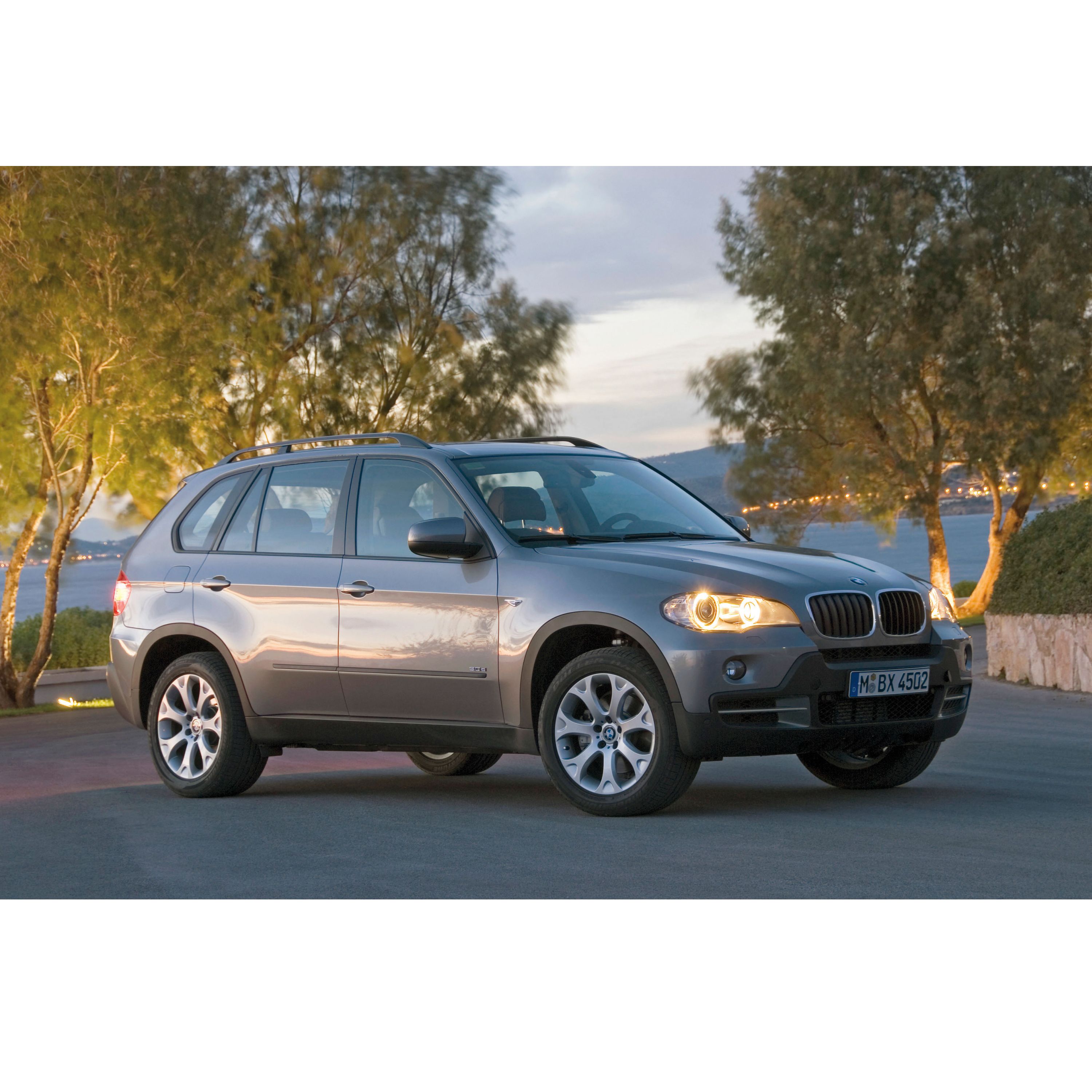
THE SECOND GENERATION (BMW E70).
In 2006, the successor to the BMW X5 appears. It impresses with technical innovations, such as Adaptive Drive. This boasts roll stabilisation and actively influences the shock absorbers. Visually, the all-terrain vehicle appears sportier and more agile thanks to the revised design. Among other things, this is down to the distinctive wheel arches. The headlights have an integrated, ring-shaped side and driving light. This way, the vehicle can be identified as a BMW immediately, whether at dusk or at night. Optional third-row seating now allows up to six additional passengers to be accommodated.
In the 2010 model-year update, the SUV receives headlights sporting an LED look. And a completely updated range of engines. The driver assistance systems now include Speed Limit Info and Active Cruise Control. Another highlight is Side View. This feature involves cameras at the sides of the vehicle to provide drivers with an even better overview.
Production period: 2006 – 2013
Engines: 3.0 – 4.8 litres (173 – 300 kW, 235 – 408 hp), 6 & 8 cylinders
Length/breadth/height: 4,854 mm/1,933 mm/1,739 mm
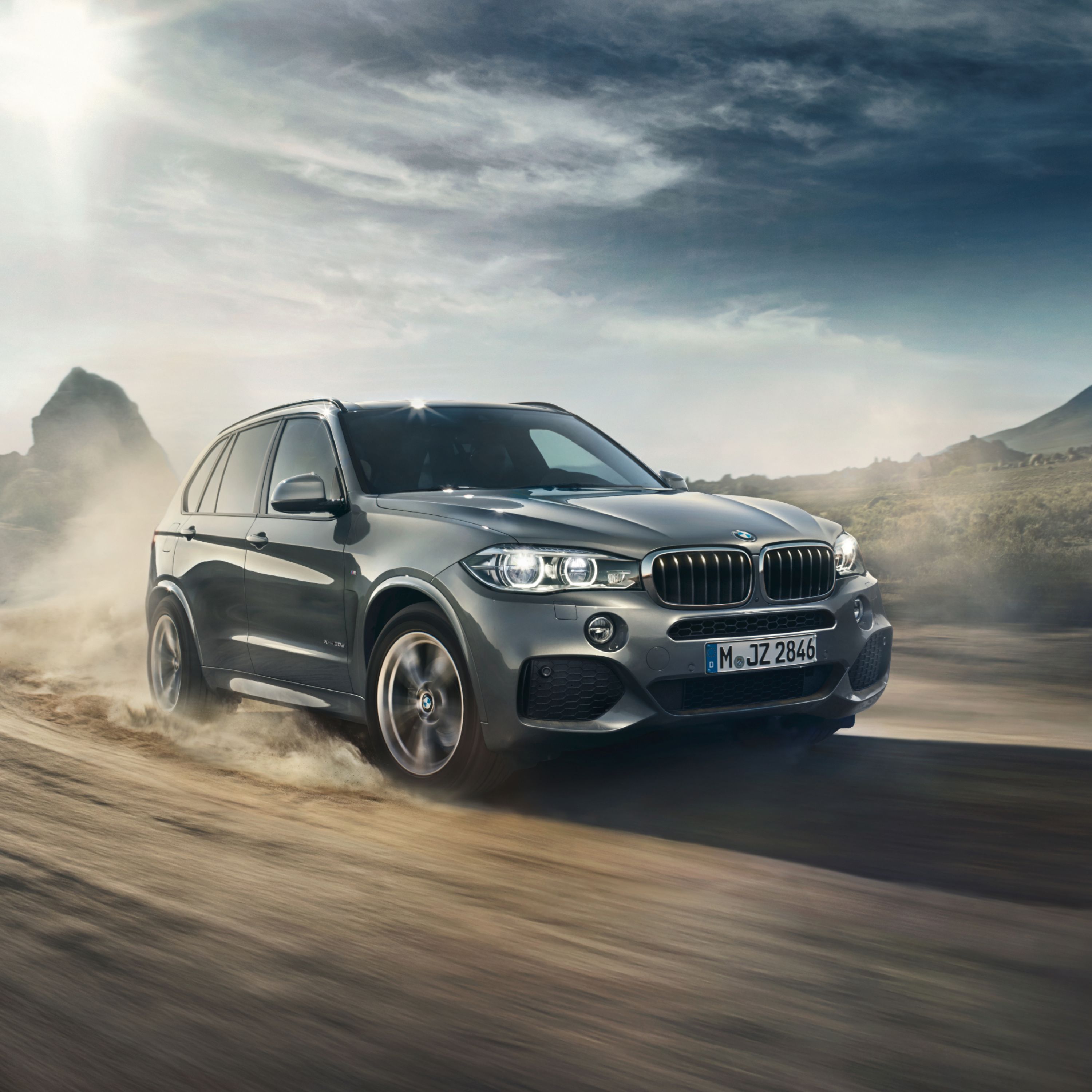
THE THIRD GENERATION (BMW F15).
The aerodynamic improvements of the third-generation are immediately apparent. A sophisticated system of air inlets in the front apron and an air outlet behind the front wheels reduces the air vortices in the front wheel arches. This reduces drag. The harmonious proportions exude sophistication, confidence and agility.
The ambient lighting in the interior looks particularly elegant. The use of elaborately processed, high-quality materials underlines this noble approach. This is noticeable, for example, in the double-stitched leather. You can control the comprehensive driver assistance systems intuitively thanks to the overhauled iDrive touch controller with its sensitive interface. This includes Cruise Control with traffic jam assistant. And the BMW Night Vision system, which makes people and animals easily recognisable in the dark.
Production period: 2013 – 2018
Engines: 2.0 – 4.4 litres (160 – 330 kW, 218 – 450 hp), 4, 6 & 8 cylinders
Length/breadth/height: 4,880 – 4,886 mm/1,938 – 1,985 mm/1,717 – 1,762 mm
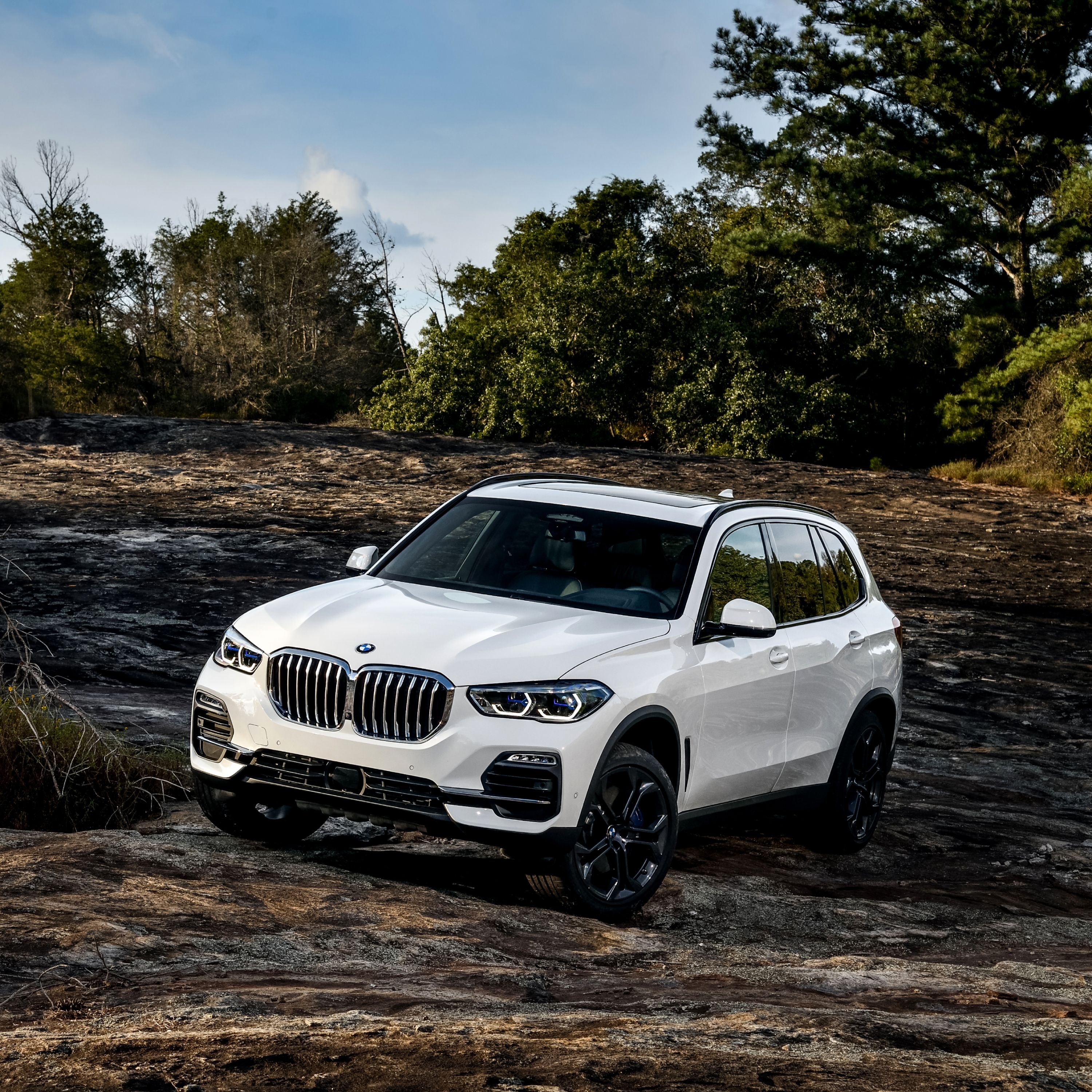
THE FOURTH GENERATION (BMW G05).
The BMW X5 is confident and striking thanks to its clearly increased dimensions and the now one-piece double kidney grille. The LED headlights can optionally illuminate the road clearly with Laserlight. The BMW Live Cockpit Professional is entirely digital and can be customised to suit your needs. You can intuitively control it with gesture and voice commands. Modern driver assistance systems support the driver in dangerous situations, such as when braking.
For off-road use, the SUV has four drive modes for different types of terrain in the off-road package. For an ideal driving experience at all times. Efficient engines and an adjustable chassis ensure agility and dynamics. As a plug-in hybrid model, the SUV offers locally emission-free and almost silent driving pleasure for your everyday journeys thanks to its auxiliary electric drive.
Production period: 2018 – 2022
Engines: 2.0 – 4.4 litres (170 – 390 kW, 231 – 530 hp), 4, 6 and 8 cylinders
Length/breadth/height: 4,922 – 4,938 mm/2,004 – 2,015 mm/1,745 – 1,747 mm
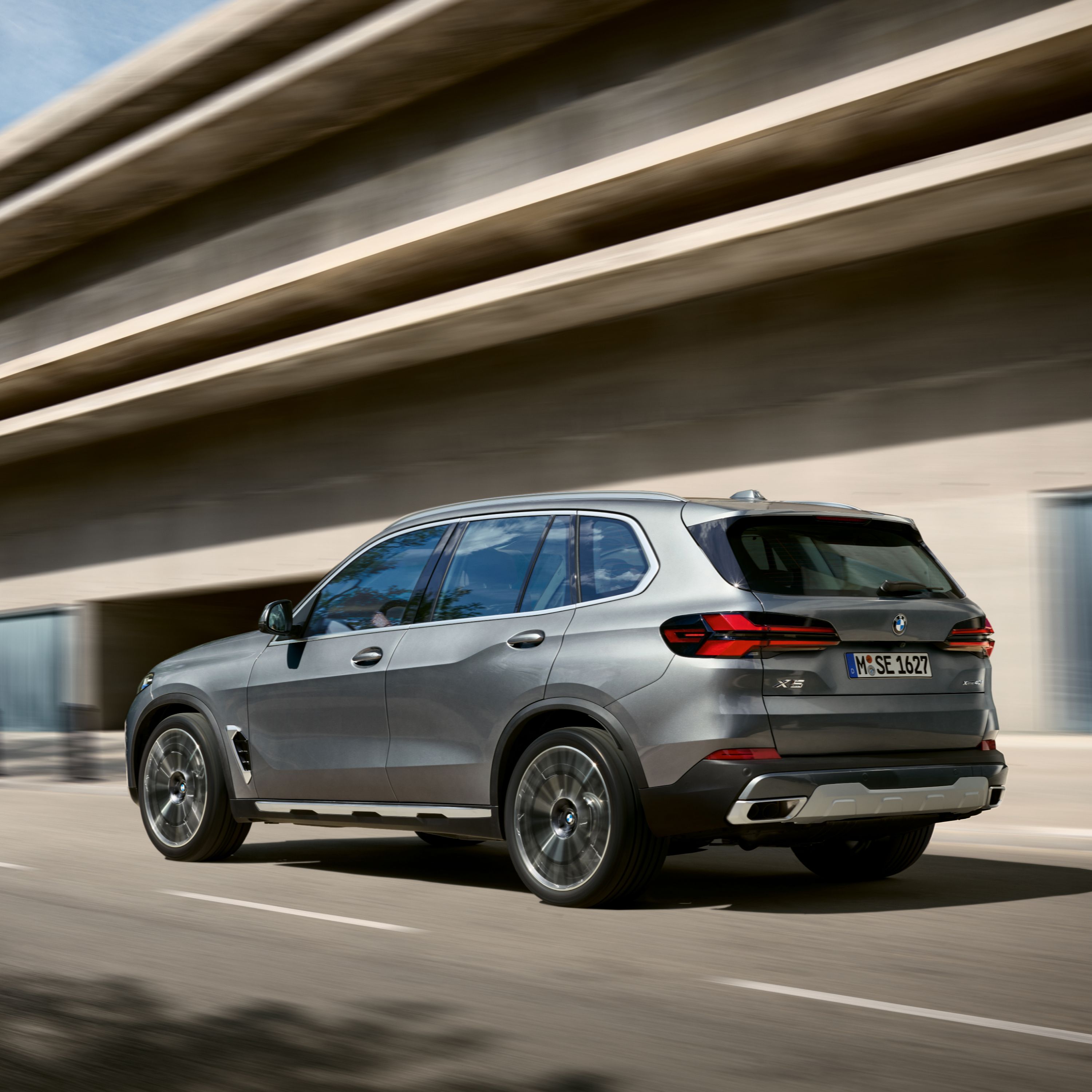
THE FIFTH GENERATION (BMW G05 & F95).
In 2022, the BMW X5 looks almost like a completely new model thanks to the extensive facelift it received on the front. A wide, horizontal surface design. The characteristic BMW radiator grille with ‘Iconic Glow’ lighting display. Revised, narrower LED headlights. Together they draw a striking and expressive face. This design approach extends to the three-dimensional LED rear lights and the wide rear stance. Depending on the package selected, the modernity (X Line) or sportiness (M Sport package) of the BMW X5 is further enhanced.
The vehicle interior is also modern. The integrated BMW Curved Display and the BMW Interaction Bar as an operating element create a multimedia experience. The ‘Crafted Clarity’ glass application provides a luxurious highlight. Hand-crafted, polished crystal glass elements decorate the selector lever with an illuminated X symbol, the start/stop knob and the iDrive Controller. Thanks to the new Trailer Assistant, you can now also drive backwards with a trailer attached.
The SUV offers sporty driving dynamics with its powerful BMW TwinPower Turbo 6-cylinder combustion engine. It impresses with top-rate driving comfort thanks to the xOffroad package and adaptive 2-axle air suspension.
Production period: 2022 – present
Engines: 3.0 – 4.4 litres (219 – 460 kW, 298 – 625 hp)[2], 6 and 8 cylinders
Length/breadth/height: 4,935 mm / 2,004 mm / 1,765 mm
THE BMW X6.

THE FIRST GENERATION (BMW E71).
Is it a Coupé? Is it an SUV? In 2008, an off-road vehicle appears on the streets that eludes any classification. The BMW X6 combines the best qualities of both vehicle classes. A car for individualists who value performance. With 6 and 8-cylinder engines, it has plenty of power, which the Dynamic Performance Control optimally implements while increasing steering precision. In conjunction with the intelligent all-wheel drive xDrive, directional stability and traction are optimised, because the drive torque can now be steplessly distributed to each wheel individually.
The all-terrain vehicle looks particularly streamlined thanks to the coupé-like side lines. In combination with the double kidney grille, the narrow headlights visually widen the front.
The design changes discreetly as part of the 2012 model-year update. The side light rings are now available in an LED look. A wider range of equipment options are also available. For example, the bonnet with power dome.
Production period: 2008 – 2014
Engines: 3.0 – 4.4 litres (173 – 300 kW, 235 – 408 hp), 6 & 8 cylinders
Length/breadth/height: 4,876 – 4,877 mm/1,983 mm/1,684 – 1,690 mm
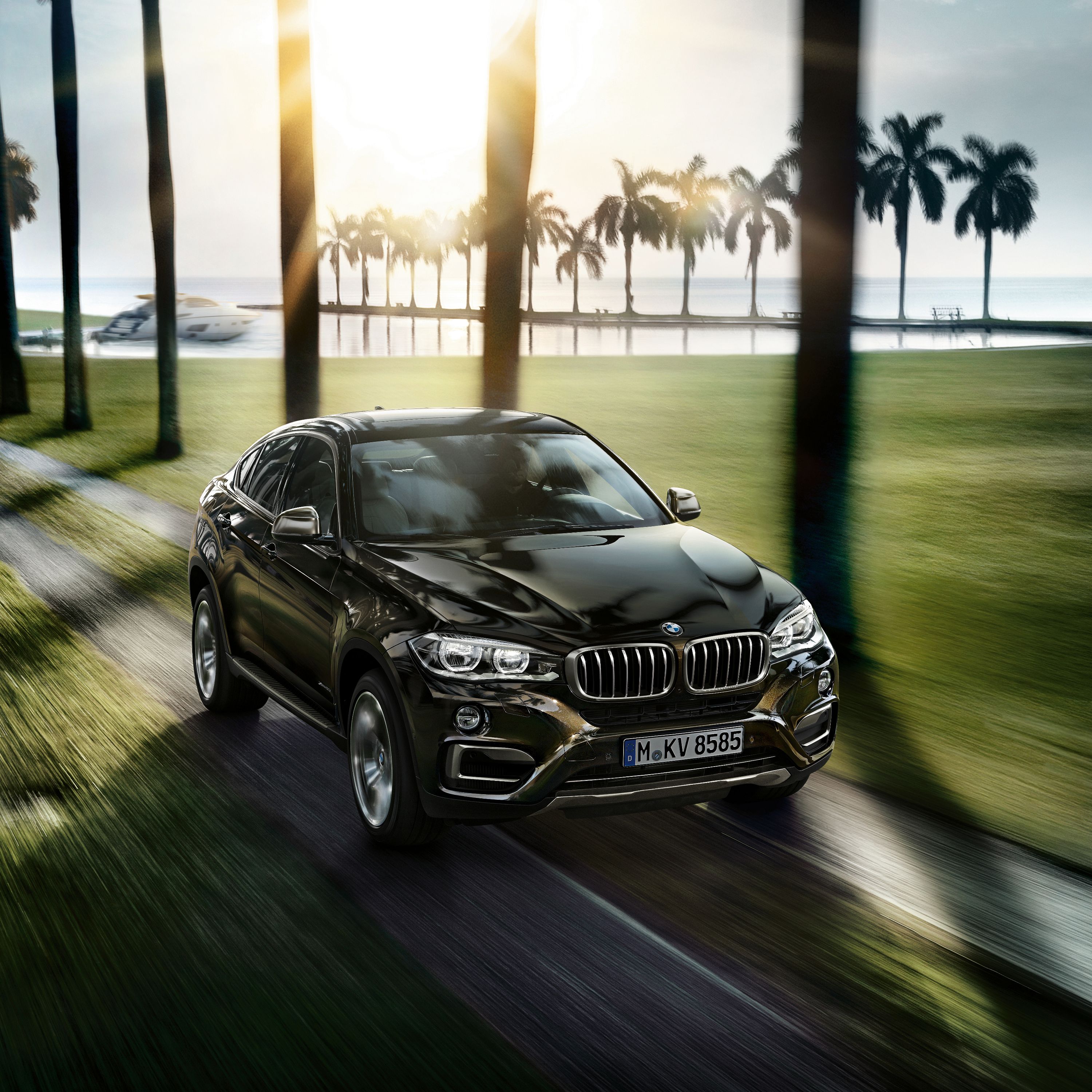
THE SECOND GENERATION (BMW F16).
The successor arrives on the scene with an even more independent character. Headlights drawn up to the double kidney grille make the SUV model look even wider. The front is even steeper. Wider tail lights now adorn the rear. The double beading on the sides catches the eye. The interior features high-quality materials, updated instruments and colour-adjustable ambient lighting. Enjoy a virtually unlimited range of music and content with streaming.
The new engines deliver more power while increasing efficiency. Together with the standard xDrive all-wheel drive and the 8-speed automatic transmission, they invite you to enjoy dynamic, agile driving.
Production period: 2014 – 2019
Engines: 3.0 – 4.4 litres (190 – 330 kW, 258 – 450 hp), 6 & 8 cylinders
Length/breadth/height: 4,909 mm/1,989 mm/1,689 – 1,702 mm
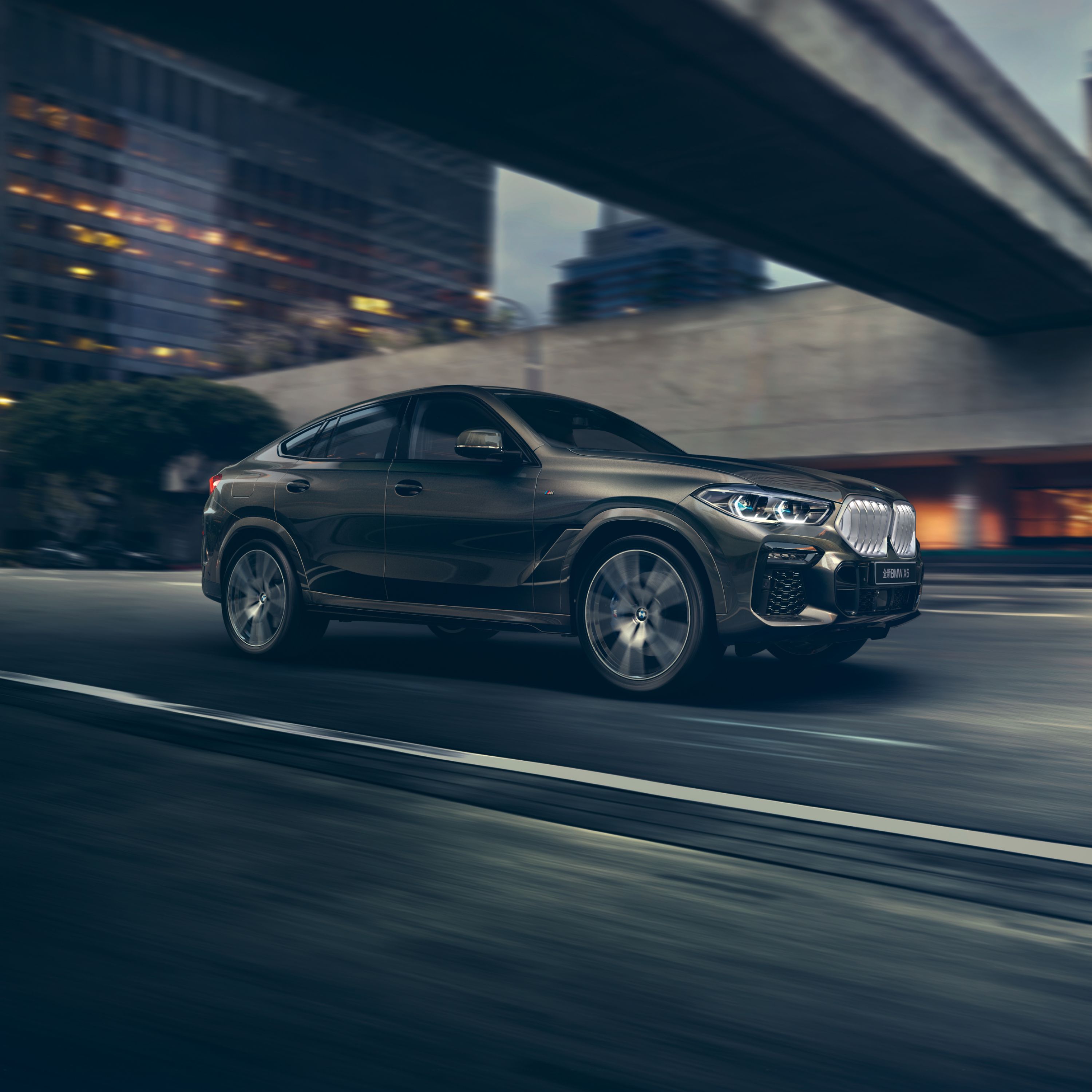
THE THIRD GENERATION (BMW G06).
In 2019, the BMW X6 boasts powerful proportions and an expressive design. Very narrow and long front and rear headlights. Large air inlets on the sides and below the double radiator grille. Thanks to its self-illumination and optional Laserlight, the SUV remains visible even in the dark. Powerful engines, intelligent driver assistance systems and the standard xDrive all-wheel drive enable particularly impressive driving dynamics.
The 20 loudspeakers of the Bowers & Wilkins Diamond surround sound system provide you with a special listening experience on demand. With the BMW X6, you can reach your destinations not only quickly and safely, but also comfortably.
Production period: 2019 – 2022
Engines: 2.0 – 3.0 litres (195 – 390 kW, 265 – 530 hp), 4 & 6/8 cylinders
Length/breadth/height: 4,935 – 4,948 mm/2,004 – 2,019 mm/1,693 – 1,697 mm
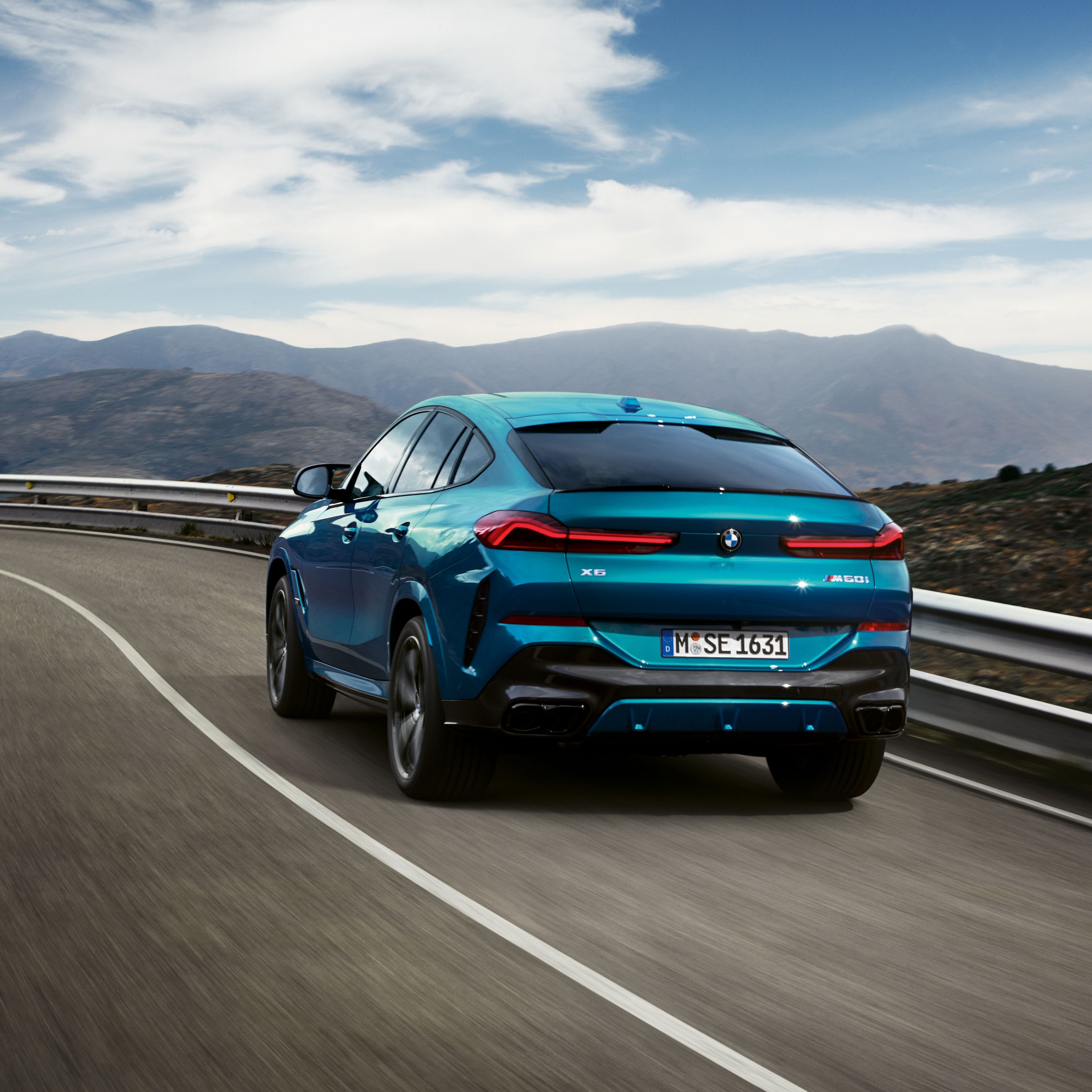
THE FOURTH GENERATION (BMW G06 & F96).
Muscular athleticism with maximum expressiveness. The fourth generation of the BMW X6 is equipped with the M Sport package as standard. The overhauled front with ‘Iconic Glow’ kidney lighting display provides a visual highlight. As well as the sporty, aerodynamically optimised design features on the exterior. The M High-gloss Shadowline, M-specific exhaust tailpipes, the 20" BMW light alloy wheels and the front and rear bumper in the M design attract everyone's attention.
Luxurious sportiness and modern technologies also define the interior. The BMW Curved Display and the instrument cluster with M-specific display, the M leather steering wheel, exclusive M pedals and door sill finishers with illuminated M designation make it particularly elegant.
With its powerful BMW M TwinPower Turbo 8-cylinder engine, the SUV model achieves pure driving dynamics. And thanks to the xOffroad package and 8-speed Steptronic sport transmission, it offers top-rate driving comfort on any surface. It is controlled directly and agilely through the adaptive M suspension and the sprint function.
Production period: 2022 – present
Engines: 3.0 – 4.4 litres (219 – 460 kW, 298 – 625 hp), 6 and 8 cylinders
Length/breadth/height: 4,960 mm / 2,004 mm / 1,700 mm
THE BMW X7.
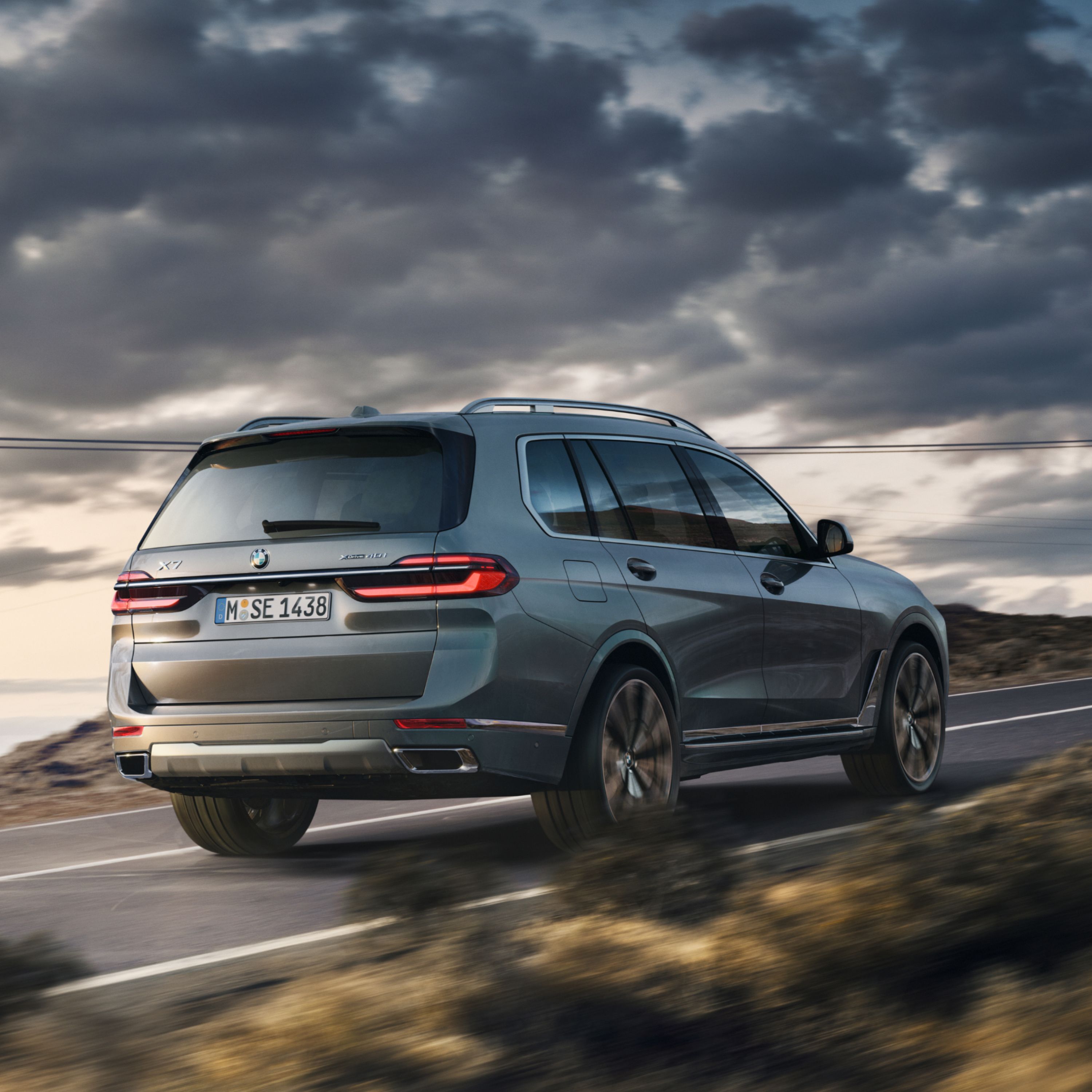
THE FIRST GENERATION (BMW G07).
When the BMW X7 appears, it is the largest SUV ever built by BMW. In this regard, it can only be compared to the later BMW XM. Nevertheless, its minimalist style and simple design language make it light and agile. Sporty, athletic and confident, it builds on the qualities typical of BMW. And redefines them. The luxurious driving comfort and powerful driving dynamics stand out in this class. This is ensured, among other things, by double control arms at the front, a five-link axle at the rear, the xDrive all-wheel drive and the 8-speed automatic transmission.
In the front interior, the driver receives all relevant information via two 12.3" displays and simultaneously controls the diverse functions and premium driver assistance systems. At the rear, two displays host the on-board entertainment. When passengers look upwards, they can see a panoramic roof as standard, which features 15,000 coloured light points in the dark. The SUV offers a wide range of customisation options. From Merino leather with contrast stitching to exclusive metallic paintwork, there is nothing left to be desired.
In 2022, the BMW X7 receives an expressive and elegant facelift. With the BMW ‘Iconic Glow’ illuminated kidney grille, the wide stance and the new exterior colour Sparkling Copper Grey metallic, its status as a luxury vehicle is manifest. The BMW Curved Display and the BMW Operating System 8 in the cockpit offer an innovative digital experience.
Production period: 2019 – present
Engines: 3.0 – 4.4 litres (259 – 390 kW, 352 – 530 hp), 6 & 8 cylinders
Length/breadth/height: 5,151 – 5,181 mm/2,000 mm/1,835 mm
THE BMW XM.
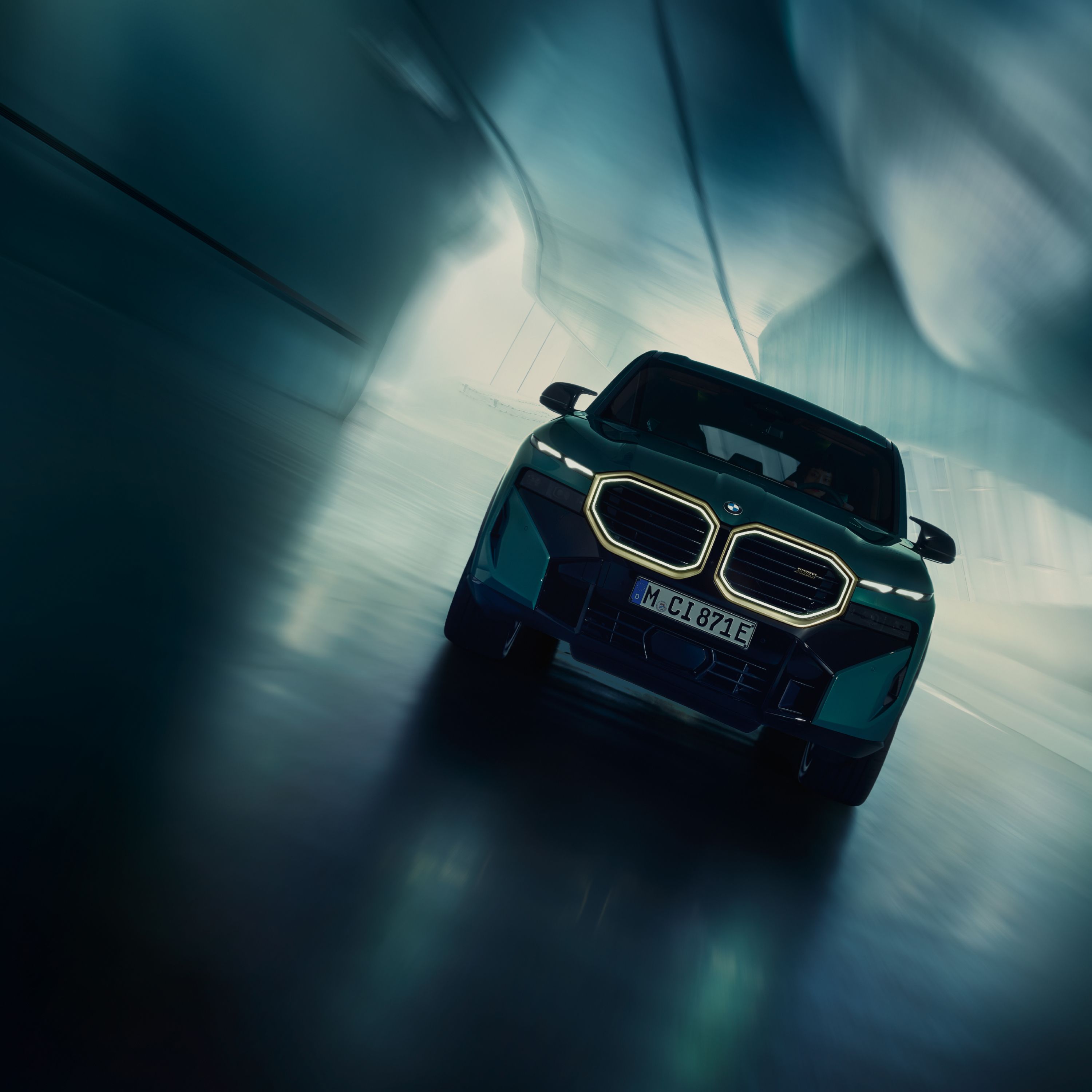
THE FIRST GENERATION (BMW G09).
Thanks to the newly developed V8 engine, the powerful BMW XM brings a mighty 550kW (748hp) to the road. And with 83 km of pure electric range (WLTP)[1], it offers silent and locally emission-free driving at the same time. Thanks to modern plug-in hybrid technology, the SUV combines the best of both worlds.
The large and powerful proportions also exhibit its uncompromising independence from afar. With its new, unmistakable front design, the BMW M brand retains its established position in the luxury segment.
The combination of BMW M and BMW X elements is also consistently maintained in the interior. The front section is performance-oriented. As is typical for BMW M, the driver is clearly the centre of attention. The new display cluster of the BMW Curved Display bridges the gap between traditional driver orientation and modern, digital functions.
The intense driver focus in the front area is juxtaposed with a cosy and luxurious lounge atmosphere in the rear. Here, passengers are greeted by a place of retreat fit for a celebrity. Thanks to high-quality materials, exquisite surfaces and expressive details. The visual highlight in the rear is the roof with a three-dimensional prism structure. Together with the ambient lighting, this element impressively showcases the interplay of progressive luxury and comfort.
Production period: 2022 – present
Engines: 4.4-litre combustion engine (360– 430 kW, 489 – 585 hp), 8 cylinders + electric motor (145 kW, 197 hp), system power (480 – 550 kW, 653 – 748 hp)[2]
Length/breadth/height: 5,110 mm/2,005 mm/1,755 mm
THE BMW iX1.

THE FIRST GENERATION (BMW U11 BEV).
In 2022, the BMW iX1 is launched as the first electric SUV from BMW. At the same time, it is the electric entry-level model in the class of the smaller BMW SUV models.
The BMW iX1 combines the high driving dynamics of a classic compact SUV with the modern efficiency of BMW eDrive technology. It offers a long range thanks to the flat high-voltage battery in the underbody and the recuperation system: up to 474 kilometres (WLTP)[1] with a single battery charge. A hefty 230 kW (313 hp)[4] round off the powerful overall package.
The bold front end and upright proportions create a modern and dynamic side view. The blue accents spotlight the electric drive of the robust vehicle. The interior of the E-SUV is also modern. Enjoy a particularly comfortable sitting experience thanks to the active seats. The elegant and frameless BMW Curved Display with touch and voice control is also the central interface to the powerful BMW iDrive.
Production period: 2022 – present
Engines: Electric motor (150 – 230 kW, 204 – 313 hp)[4]
Length/breadth/height: 4,500 mm/1,845 mm/1,616 mm
THE BMW iX2.
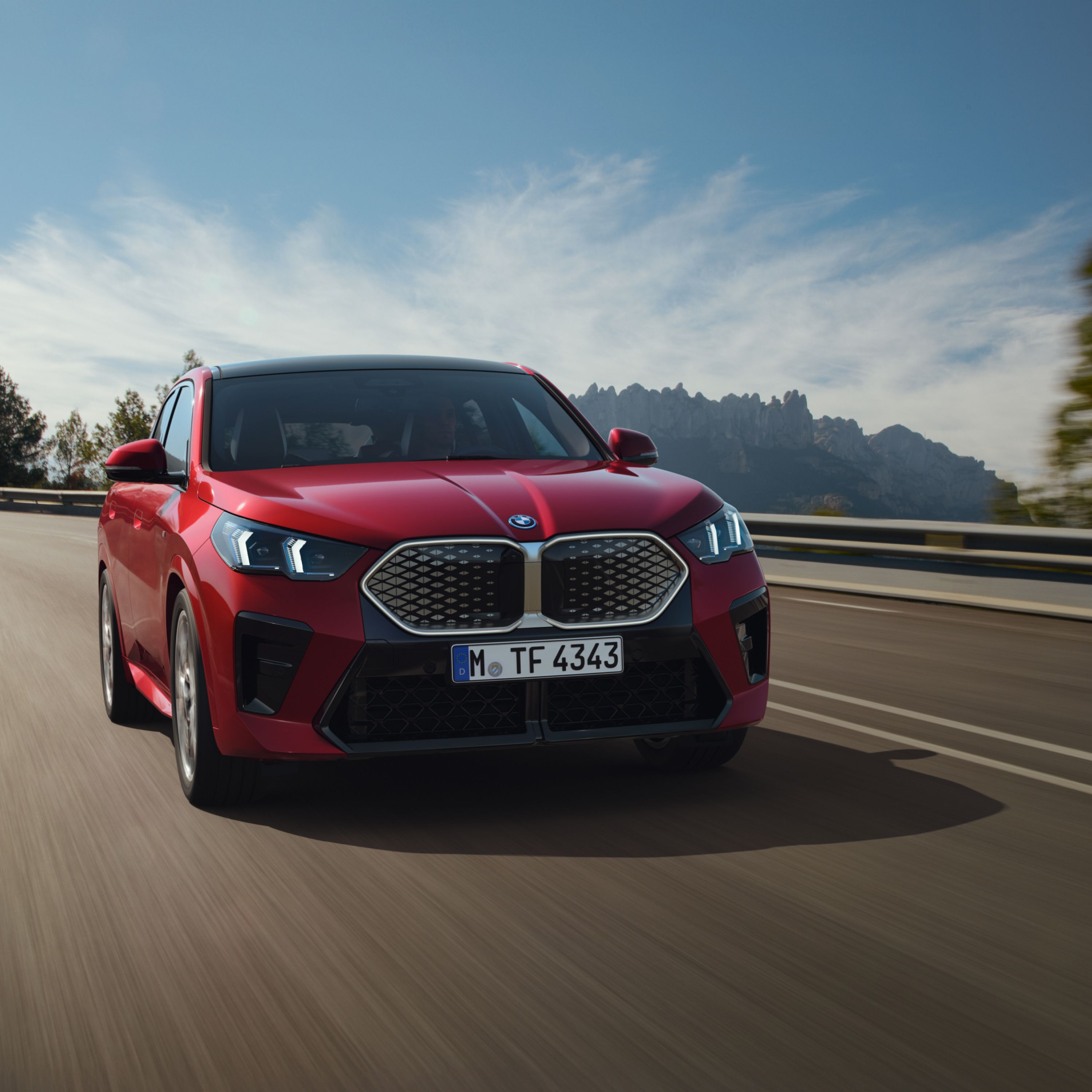
THE FIRST GENERATION (BMW U10 BEV).
The 2024 BMW iX2 combines the spaciousness of an SUV with the advantages of all-electric drive. It has a powerful design with striking lines and an SUV coupé silhouette. At the front, the BMW Iconic Glow illuminated kidney grille makes an impressive statement. In combination with the 20" M light alloy wheels, the equipment of the M Sport package clearly gives the BMW iX2’s sprightly appearance a further boost.
The SUV is as elegant on the inside as it is powerful on the outside. Its ergonomic sport seats provide optimum support even with a sporty driving style. Use the large BMW Curved Display and BMW Live Cockpit Professional with Operating System 9 to intuitively control music, gaming and convenient navigation with a clear view of the route. And thanks to the 12 speakers of the Harmon Kardon hi-fi system, your favourite music will sound even more impressive! The premium panoramic glass sunroof opens up the space above, making the interior appear even larger from every seat.
With 230 kW (313 hp)[4] of power, the BMW iX2 accelerates from 0 to 100 km/h in 5.6 seconds. As well as excellent driving dynamics, you also benefit from intelligent driver assistance systems, like the Parking Assistant Plus, for example, that also offers a 3D view of your surroundings. Or the Driving Assistant Professional, which safely maintains your lane and distance.
Production period: From 2024
Engines: Electric motor (230 kW, 313 hp)[4]
Length/breadth/height: 4,554 mm/1,845 mm/1,560 mm
THE BMW iX3.

THE FIRST GENERATION (BMW G08 BEV).
Still a concept vehicle in 2018, the electrified version of the BMW X3 arrived at the dealerships in 2021. Thanks to BMW eDrive technology of the fifth generation, the BMW iX3 offers impressive driving dynamics with 210 kW (286 hp) of power. The torque of 400 Nm is immediately available at all times. Together with the cleverly tuned chassis, it is particularly dynamic on the move. And also over longer distances. Thanks in no small part to the recuperation system, the pure electric range (WLTP) is 450 kilometres[1].
But the electric SUV also impresses in the interior. A modern, elegant ambience meets an animated BMW Live cockpit and details such as the blue start button. The BMW iX3 feels at home both in urban surroundings and off road.
Production period: 2021 – present
Engines: Engines: Electric motor (210 kW, 286 hp)
Length/breadth/height: 4,734 mm/1,891 mm/1,668 mm
THE BMW iX.
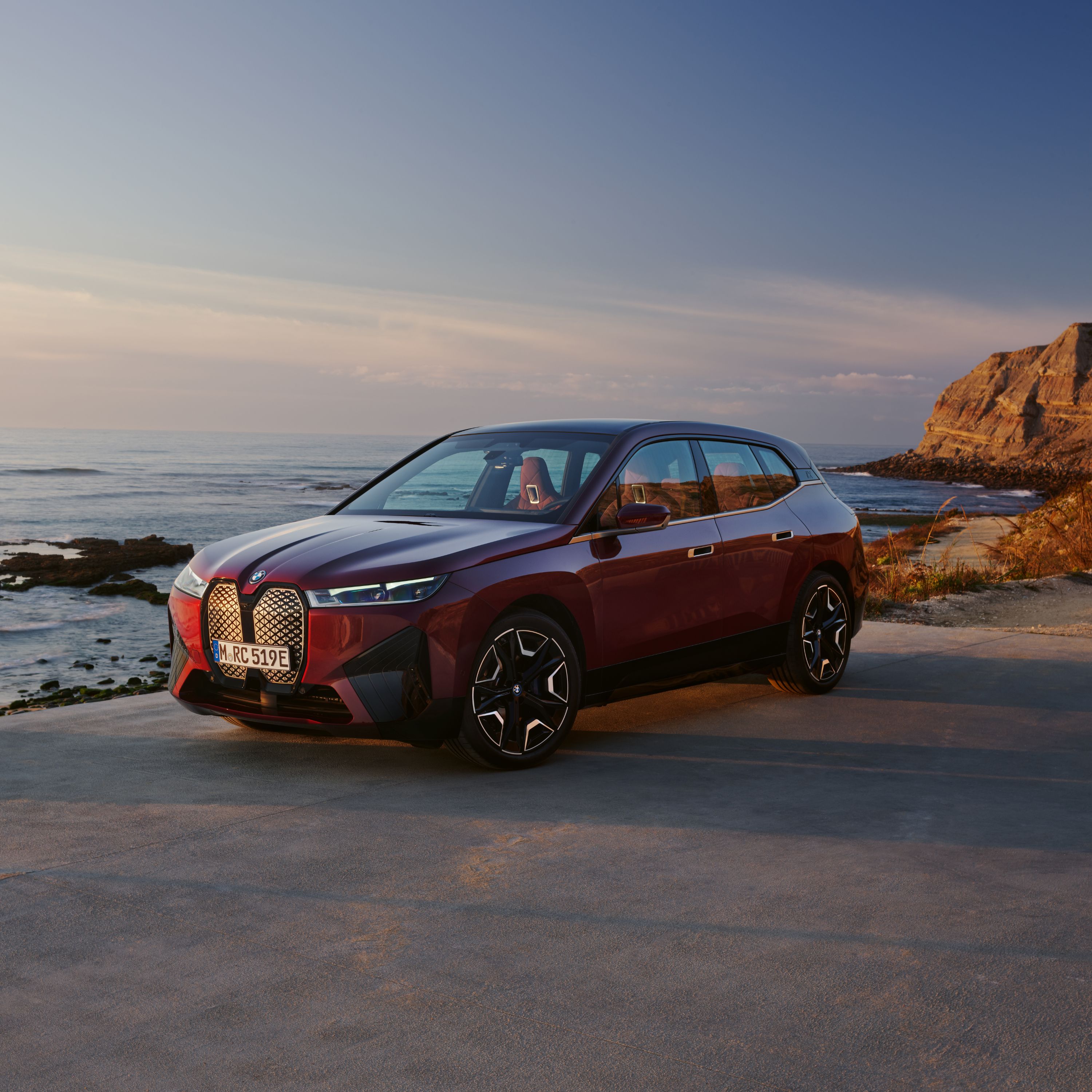
THE FIRST GENERATION (BMW i20).
Even the front of the BMW iX guarantees an expressive appearance. The extremely narrow headlights contrast with the expansive double kidney grille. Behind this, a large number of sensors are ready for use. In addition, there is the clean, consistently aerodynamic design with the recessed door handles and a clear design language.
With an impressive range (WLTP) of up to 630 km[1] and an output of 385 kW (523 hp), the E-SUV impresses with technical precision, sophistication and suitability for day-to-day use.
Inside, the BMW iX continues comfort, sportiness and innovation in a completely new interior experience. The completely redesigned iDrive is the logical evolution for simple and natural operation. All notifications appear on displays facing the driver or are projected onto the windscreen via the head-up display. Comprehensive driver assistance systems offer a comfortable and safe driving experience. The BMW iX is a clear choice for a future-oriented, all-electric SUV in the premium class.
Production period: 2021 – present
Engines: Engines: Electric motor (240 – 455 kW, 326 – 619 hp)
FREQUENTLY ASKED QUESTIONS.
Consumption and CO2 emissions.
BMW iX M60[1]:
Energy consumption, combined WLTP in kWh/100 km: 24.7–22.0;
Electric range, WLTP in km: 500–563
BMW iX[1]:
Energy consumption, combined WLTP in kWh/100 km: 24.7–19.4;
Electric range, WLTP in km: 403–633
BMW iX3[1]:
Energy consumption, combined WLTP in kWh/100 km: 18.0–17.6;
Electric range, WLTP in km: 461–471
BMW iX2[1]:
Energy consumption, combined WLTP in kWh/100 km: 17.7–15.3;
Electric range, WLTP in km: 417-478
BMW iX1[1]:
Energy consumption, combined WLTP in kWh/100 km: 18.1–15.4;
Electric range, WLTP in km: 417–474
BMW XM[1]:
Fuel consumption, combined WLTP in l/100 km: 2.0–1.5;
CO2 emissions, combined WLTP in g/km: 45–35;
Energy consumption, combined WLTP in kWh/100 km: 33.6–31.5;
Electric range, WLTP in km: 76–84
BMW X7 M60i xDrive:
Fuel consumption, combined WLTP in l/100 km: 12.9–12.1;
CO2 emissions, combined WLTP in g/km: 292–273
BMW X7:
Fuel consumption, combined WLTP in l/100 km: 12.9–7.8;
CO2 emissions, combined WLTP in g/km: 292–203
BMW X6:
Fuel consumption, combined WLTP in l/100 km: 12.3–7.1;
CO2 emissions, combined WLTP in g/km: 279–187
BMW X5[1]:
Fuel consumption, combined WLTP in l/100 km: 12.5–0.8;
CO2 emissions, combined WLTP in g/km: 283–19;
Energy consumption, combined WLTP in kWh/100 km: 30.7–26.3;
Electric range, WLTP in km: 87–102
BMW X3[1]:
Fuel consumption, combined WLTP in l/100 km: 9.5–2.1;
CO2 emissions, combined WLTP in g/km: 216–47;
Energy consumption, combined WLTP in kWh/100 km: 23.5–21.5;
Electric range, WLTP in km: 39–44
BMW X2 M35i xDrive:
Fuel consumption, combined WLTP in l/100 km: 8.1–7.7;
CO2 emissions, combined WLTP in g/km: 183-174
BMW X1[1]:
Fuel consumption, combined WLTP in l/100 km: 8.1–0.7;
CO2 emissions, combined WLTP in g/km: 183–16;
Energy consumption, combined WLTP in kWh/100 km: 19.3–16.8;
Electric range, WLTP in km: 71–86
The values of fuel consumptions, CO2 emissions and energy consumptions shown were determined according to the European Regulation (EC) 715/2007 in the version applicable at the time of type approval. The figures refer to a vehicle with basic configuration in Germany and the range shown considers optional equipment and the different size of wheels and tires available on the selected model.
The CO2 efficiency specifications are determined according to Directive 1999/94/EC and the European Regulation in its current version applicable. The values shown are based on the fuel consumption, CO2 values and energy consumptions according to the NEDC cycle for the classification.
When charging times are shown they can be affected by a number of factors such as type of charger, voltage supplied to the charger/car and type of current (AC or DC) supplied to the charger/car. The car also plays a role in charging times as it can be set by the driver to accept various different amperage and should preconditioning be used to heat or cool the vehicle while charging this will also affect the charging time.
The basis for the calculation of the charging times for 100 km range is the electric consumption of the vehicle based on the use of a high-Powered Charging station (HPC) or charging type and current as indicted in the literature above. The testing procedure measures are based on a 23 degrees Celsius battery start and ambient temperature with certification values excluding additional auxiliary consuming devices and systems within the vehicle such as seat heating, displays, air conditioning.
Individual consumption (fuel economy) may differ due to driving profile, vehicle load profile, auxiliary consumer usage, temperature, and ambient conditions. Consumption is based on WLTP or NEDC (whichever is indicated) best case conditions and is independently tested for BMW Group. If you are comparing this range with other models or brands make sure they are stating the same WLTP or NEDC testing regime. These results can be used to compare vehicles on a close to “like for like” basis but are unlikely to be achieved in real world conditions for reasons including temperature variation, driving conditions and the use of the auxiliary systems referred to above.
Information provided and images displayed on this site include overseas models and may show some features not available in New Zealand. Please contact an authorised BMW dealer for specific information on vehicles and features available in New Zealand. Product changes may have been made since production of this content.
Note: To obtain NZ CO2 figures for vehicles imported by BMW Group NZ in relation to the NZ Clean Car discount or “FeeBate” you will need to contact your preferred dealer. The Clean Car discount figures sourced from your dealer will differ from those listed in the BMW owner’s handbook and reported figures as they have been converted by the NZ government to WLTP3 from figures derived through one of the following testing procedures: WLTP4 or NEDC or Japanese JC08 mode or Japanese 10-15 mode or CAFE test cycle.
For all vehicles not imported by BMW NZ (Used vehicle imports) you will need to contact the source market for these CO2 figures as BMW Group NZ has no access to and cannot source this CO2 data.
For more information on the New Zealand Clean Car Programme, please visit https://www.nzta.govt.nz/vehicles/clean-car-programme/
[1] Range depends on various factors, in particular: individual driving style, route characteristics, outside temperature, heating/air conditioning, pre-conditioning.
[2] For plug-in hybrid: Electric drive depending on battery charging level.
[3] Composed of combustion engine drive (115 kW) and electric drive (14 kW).
[4] Temporary uprating <10 seconds in excess of specified nominal value. The figures for performance, consumption and CO2 emissions refer to vehicles with standard transmission.
